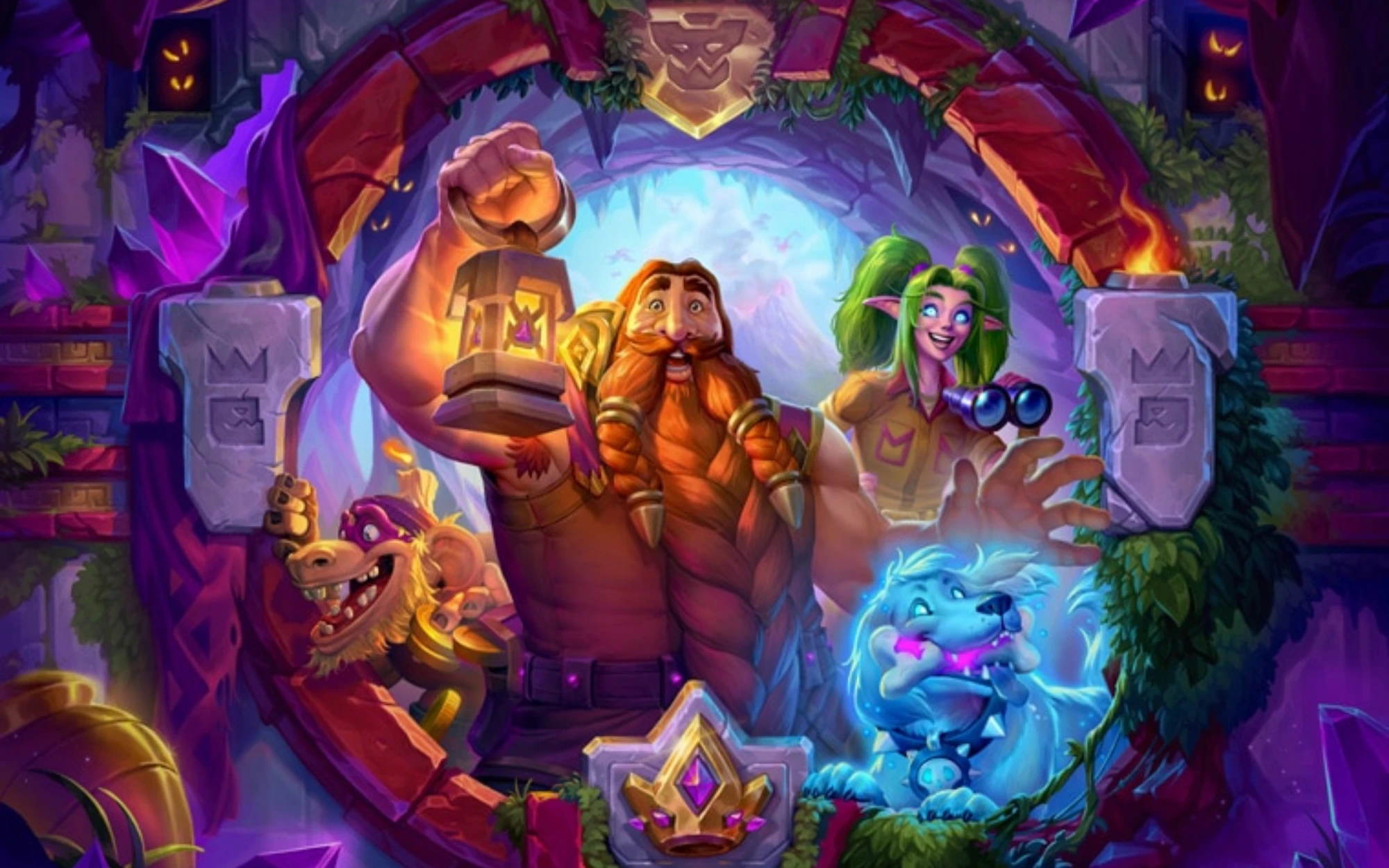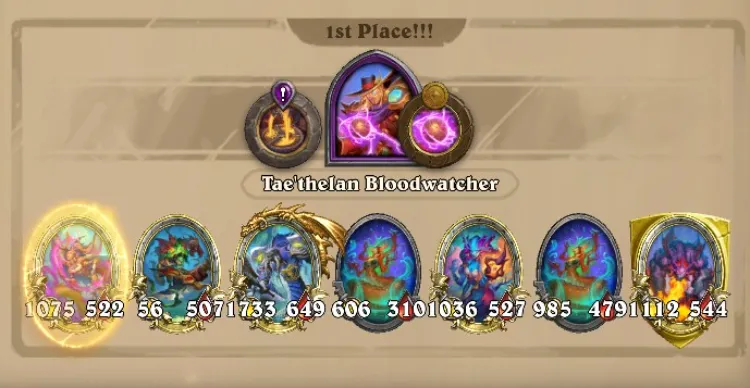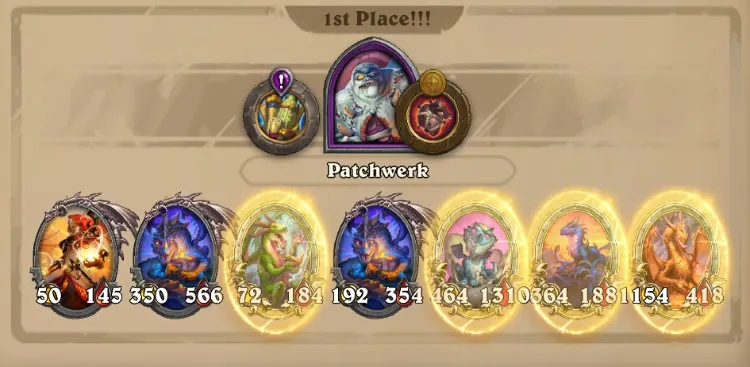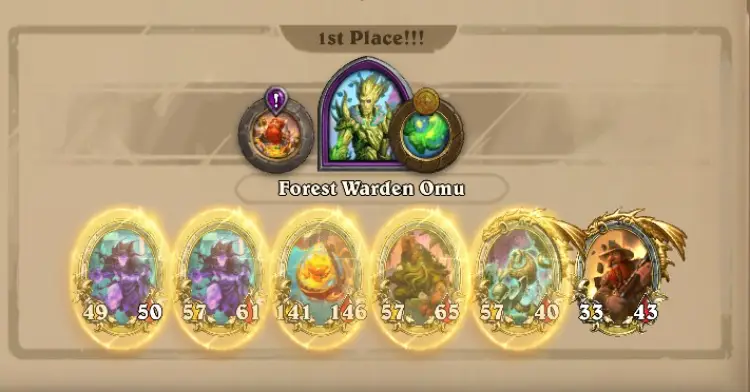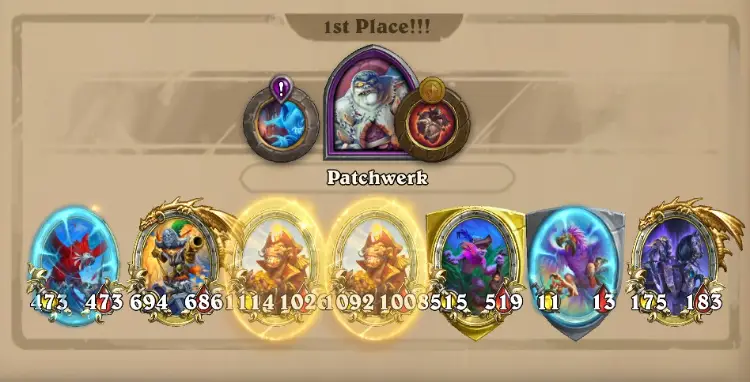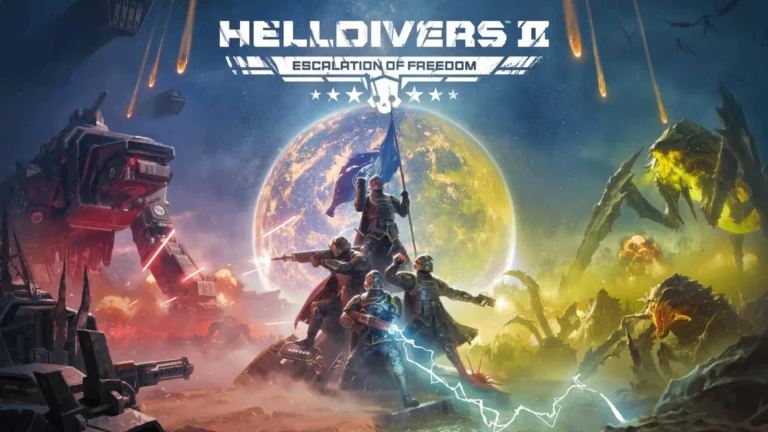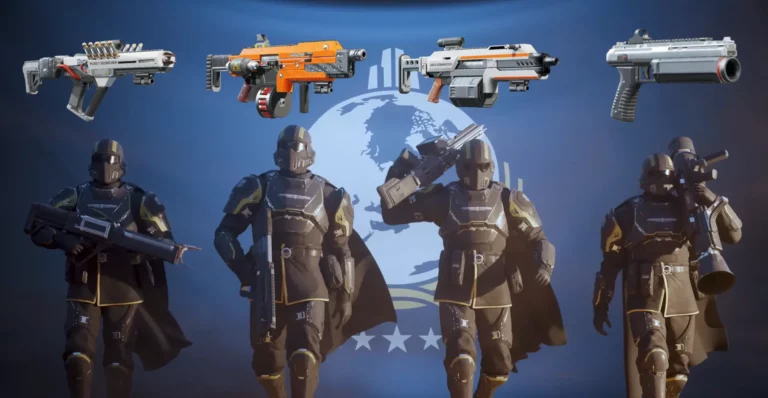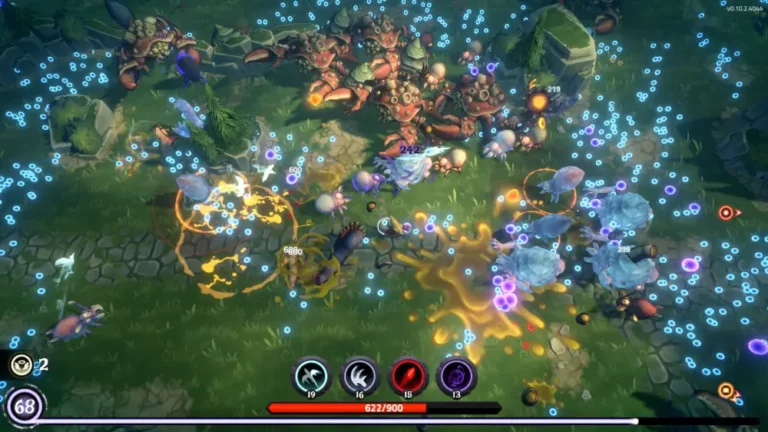The new Season 11 of Hearthstone Battlegrounds has begun on the 1st of August! We have seen many changes compared to the previous seasons, specifically, Quests are back!
Season 12 is here (2. December). We are currently playing and will drop a big update in several days. We took a little break in the mid season so we are pumped for new meta. Stay tuned!
In chronological order, the last few Hearthstone Battlegrounds seasons looked like this:
- Season 9 (December 2024): Trinkets are removed, and many tribes have been reworked. Mid-season update: Anomalies.
- Season 10 (April-May-Jun-July 2025): Trinkets are back.
- Season 11 (August 2025): Quests are back! <- You are here.
Patch 33.2 marked the beginning of Season 11 by removing Anomalies from the game, adding many new minions, bringing back old minions, and removing minions from the game. Furthermore, as stated in one of the previous patches, Tavern Spells and Duos mod will now be an integral part of the game! For Duos, check out our full HS BG Advanced Duos Guide. The biggest change in Season 11 of Hearthstone Battlegrounds is the addition of an old-new game mechanic – Hearthstone Quests. We will cover the most commonly used quests in this guide in the build sections. Also, as we mentioned before, we have published a different guide (link above) for Battleground duos as gameplay mechanics are much different than those in the regular mod, including the build types.
In this guide, we will talk about the overall gameplay flow and analyze the best meta builds for every minion type (tribe), but also what kind of builds can counter it and what Tavern Spells and Quest rewards you should go for when playing a specific build. You can check out our full Hearthstone Battlegrounds Hero guide, as they will not be included in this article since variations are too vast. Without further ado, let’s dive deep into the Hearthstone Battlegrounds Guide and explore meta builds for each tribe.
General Hearthstone Battlegrounds Season 11 Tips and Strategies
Even though you will find a lot of specific builds in this guide, the essence of your gameplay needs to be your understanding of tempo and when to level up. Below we put some very loose and general guidelines on how to play early and midgame, but the issue still remains – Hearthstone Battlegrounds is extremely RNG-based and there are almost infinite scenarios that can happen with minions, your hero power, spells, combos, etc.
This is why you need to actually play the game a lot in order to develop an instinct/feel for the game. When to level up the Tavern? Do I go for a greedy play? Is my army strong enough to survive the next battle? Should I refresh and try to find this specific minion or just buy these 2 random strong ones right now? All these questions are answered by your feel and in-depth game knowledge. We mention this to say the next thing – going for a specific build isn’t really straightforward, since RNG is straightforward.
There are a few floating concepts on which the game revolves around:
- Current Army Strength aka. Tempo – Going for a high-stat early army can secure your leeway to level up the Tavern a few turns in a row.
- Generating Resources – You will need to find a way to generate something after each turn – minions, spells, gold coins, etc. This will be essential for actually developing a strong build.
- The Lobby aka. Other Players – You need to keep an eye on and play a guessing game on who will be strong, who is currently strong, what are they playing (in order to counter it), and the potential of other players.
- Countering and Tweaking Builds – Since the game is very situational, it’s important to know how to counter your opponent. For example, if you’re playing Murlocs and have no Divine Shields, your last opponent has Mechs. Grabbing a Tunnel Blaster, you win the game here.
- RNG Above All – Sometimes, even though you did the “good” play, RNG can still punish you. The key thing here is to go for the play that has the highest chance of succeeding.
This kind of stuff is really hard to teach, given its extremely volatile nature. The best thing you can do is play a lot and watch other high-level players and see how their brain works in certain scenarios.
Note: Keep in mind that the images of the builds that you will see are taken on a specific turn or at the end of the game. The builds look different in early-game, mid-game, and late phases so please refer to the description of a specific build to learn more.
Tavern Spells Overview
Tavern Spells are essentially one-time-use abilities that you can buy from Bob’s Tavern for various gold costs. With every refresh, a new Tavern Spell will appear. Only one spell will appear with each refresh unless there is a minion or hero that modifies the number of them. You can check out our full Tavern Spell guide for more details, but here, for the sake of this guide, we will just go through a rough breakdown of the types of Tavern Spells that you can get. In total, there are 4 groups of Tavern Spells:
- Stat-boosting Tavern Spells: These Spells give you various stats. Most of them are cheap and low-level, but there are some high ones as well. Usually, these Tavern Spells are used as gold dumps or in specific scenarios in which you need to buff up one of your minions. Examples of Stat-boosting spells are: Pointy Arrow, Them Apples, and Natural Blessing.
- Economy Tavern Spells: Spells that give you extra Gold or free Refreshes are economy ones. They are very useful and can turn the tides in your favor, especially if you acquire them early on. Examples of Economy Spells are: Careful Investment, Tavern Coin.
- Utility Tavern Spells: Spells that give or remove Taunt, provide Divine Shield, and increase the number of Deathrattles, Battlecries, or End of Turn effects that you get are what we call Utility Tavern Spells. They can come in handy for specific build types, which we will discuss later on in the article.
- Discovery Tavern Spells: Several spells allow you to Discover or get a free minion. We will just call them Discovery Tavern Spells as most of them do allow you to Discover a minion of a specific type. Examples of these spells are: Contracted Corpse, Planar Telescope, Hired Headhunter.
Early-game Tips
- Turn 1 (3 gold): Most economy minions have been reworked and are now Tier 2. In season 11, it’s better if you can get something that gives you enough sustain for the next 3 turns (minions with Deathrattle, Reborn, or Divine Shield, since in the beginning most minions have low defense). If you are so unlucky that there are none of those as well, pick the one with the highest defense because probably your opponents will have a minion with one of the aforementioned effects.
- Turn 2(4 gold): Upgrade to Tavern Tier 2. The last thing you want to do is to waste 1 gold in this turn by buying 1 minion and then waste 2 more in the next one. Freeze if there are any Economy minions in Tavern. This is general advice, and there are exceptions to this rule if your hero power or a spell can provide higher value.
- Turn 3(5 gold): Whatever you do, do not refresh unless you upgrade. Three options are viable here: 1) Buy 2 minions if you managed to get an economy minion; 2) Go for a useful Battlecry minion, sell and buy one minion; 3) Upgrade to Tavern Tier 3 4) Buy a useful spell, preferably an Economy one. There is a 5th option here – use a hero power if it grants you stats or any kind of stat boost and then upgrade to Tavern Tier 3.
- Turn 4(6 gold): This is the QUEST turn, you will need to choose wisely. Look for a decent reward and a double quest, especially if it happens to synergize well with your current board and/or Hero Power. This turn will be dictated by your Quest, so for example, if you have “Gain stats 18 times”, you can buy something that keeps racking up stats, for example – Yrel.
- Turn 5 (7 gold): If you haven’t upgraded to Tier 3, buy one minion and upgrade. Again, do not refresh and, again, go for Economy spells if there are any, focus on the quest.
- Turn 6(8 gold): Based on your board, decide what you want to go for at this time. Do not overcommit for the Quest reward, especially if the reward is only good at the later stages of the game. Sometimes there is no need to rush, but sometimes you can see an “opening” into solving the Quest early on.
- Turn 7 (9 Gold) You will need to choose at this point, do you go for Tempo/Quest/Tavern Upgrade, sometimes, Tempo and Quest can overlap and this is the ideal scenario.
Mid-game Tips
- First of all, during all turns from now on, use your time. Do not rush and do everything in 10 seconds, you have plenty of time to think about your strategy before the rope starts burning.
- You need to develop some spell/minion/gold generation at this point. The plan is to have enough resources to propel you into Tier 5/Tier 6 late-game phase. Look at the board and what you have in Tavern. Think about the plan here – how many more minions do you need to obtain the key ones? Do you have supporting minions for a specific desired build? If not, can you avoid taking damage next turn? Who is your next opponent? The reason why you need to devise a strategy is that players who end up in the lower section of the arena start to die here.
- Pay close attention to what kind of Tavern Spells are offered. It’s a good idea to boost your game tempo by using Tavern Spells instead of wasting gold on Refresh.
- The Reward from your Quest is your main power source, or most of the time it will be. Be sure to pick one that can work with your current comp.
- Upgrading: If key minions for the desired build are Tier 4 or lower, there is no need to upgrade yet. Many players make mistakes at this point and, for no reason, go for the Tavern Tier 5 instead of sticking to what they have. This is especially important if you have a low-tier build. Remember, you don’t even have to end up on Tavern Tier 6 in order to win the game.
- Fortune Favors The Bold – RNG does not. As we previously mentioned, it’s important to understand how to play around RNG. The point is to go for the highest success rate, and not rely on getting Brann Bronzebeard in the next two Refreshes for example. Moreover, if you see that you’re “screwed” and just know your gonna lose if you level up to Tier 5, settle for a low-tier Dragon/Beast/Scam build. Do not upgrade. Try to simply boost stats and try going for as many scam minions as you can get or a dedicated low-tier build. It’s all hands on board at this point – simply buy whatever is the strongest in the Tavern and what will allow you to survive the longest so that you don’t lose (too much) MMR. We know this isn’t ideal, but sometimes you won’t make ideal choices plus RNG will wreck you. This is where you just settle for a 3rd/4th/5th place and try not to be last.
End-game Tips
- Determine your main opponent – scout and see who is likely to be your final competitor for the first place. Start preparing to counter their build. Check out our counters for each build below in this article.
- Consider getting a backup minion such as Leeroy the Reckless. Sometimes, especially in lower MMR games, players focus on buffing one or two minions so you need a counter if that’s the case.
- If you have a full build at this point and are above 20hp, you can upgrade to Tier 6. It’s the logical thing to do because if your main opponent one-shots you in a duel and wins, well then you never stood a chance in the first place. It’s much more likely that you will need an additional boost from Tier 6 minions to overpower your main opponent.
- Once you are on Tavern Tier 6, you will be able to get some high-end spells such as Azerite Empowerment. Depending on whether your build is complete, consider spending Gold to boost your forces with these Tavern Spells. This is all very situation, of course.
- Pay close attention to the lineup on your board. As at this point you probably know your opponent’s build, try to predict which minion will attack where and align your own forces in accordance with that prediction. There are simply too many variations to consider at this stage of the game so we can’t give you straightforward advice. For example, if you are up against Mech Magnetization build, your weakest minion should go on the far left side as probably your opponent has Taunt and Divine Shield so you don’t want to waste any minions on hitting that. But on the other hand, if your opponent is going for any Demon build, probably he won’t have any Divine shields on his Taunt minion, so you should put Venomous or the highest attack minions on the left side. Check out the builds below for more info.
Demon: Lord of the Kaboom Build
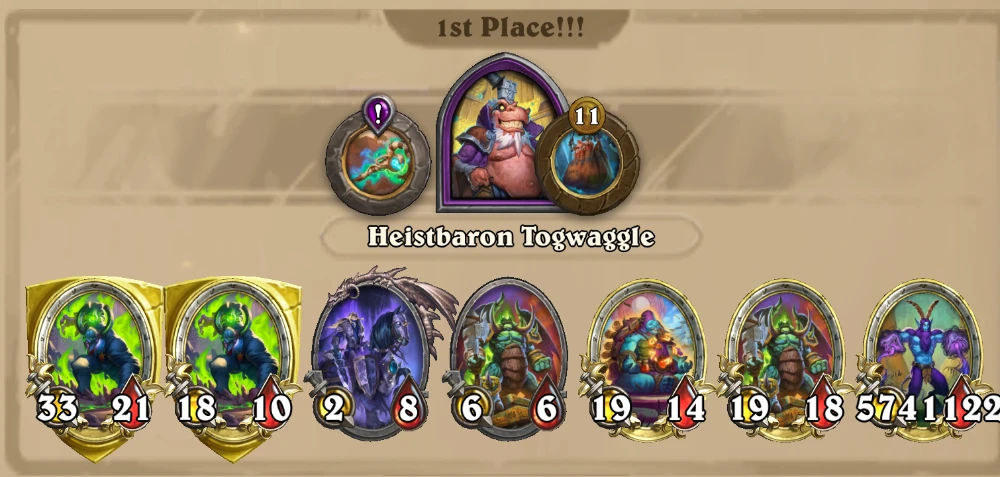
Key minions: Silent Enforcer + Lord of the Ruins (Deathrattle build), Insatiable Ur’zul + Felblaze Leader (Eats Build)
Support minions: Titus Rivendare (Deathrattle Build), Shadowdancer with Felfire Conjurer/Cupcake Peddler (Eats Build)
For more info on each Demon minion, check out our full Demon tribe overview.
Concept: The general idea of demons in Hearthstone Battlegrounds Season 11 is twofold. There is still the “Eats build” and it’s pretty strong due to recent Insatiable Ur’zul buffs and some new minions, but there is also another build that revolves around getting Silent Enforcer and Lord of the Ruins. There are a lot of changes to the demon tribe in this season, but we are used to demons getting a lot of changes over the past year.
Early game: In the early game, Demons have a decent arsenal for tempo, with minions like Piggyback Imp and Stray Satyr. Once you get to tier 3 minions, you will have to aim for the ultimate early game tempo combo, and that is Soul Juggler and Void Earl. The combination of these two will win you most battles at this stage of the game.
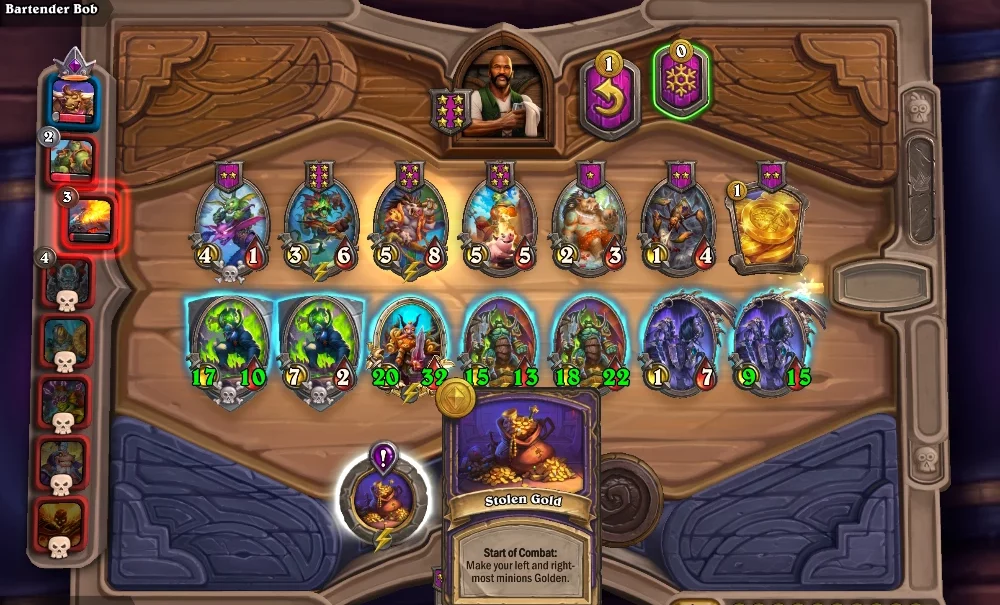
Mid-game: In the mid-game, things get a bit complicated, since there are a lot of pathways and minions that you can buy in order to play a certain build. You essentially have the new Felblaze Leader, which is compatible with the Eats build and Insatiable Ur’zul, but you also have Devout Hellcaller, which is more of a build that revolves around getting Silent Enforcer, and also, if you already have a Soul Juggler. Shadowdancer is also an option, but do keep in mind that if you don’t have stats buffed on your spells and Felfire Conjurer or some other way of getting stats on your spells, he is pretty slow and useless, since Staff of Enrichment now gives +1/+1 at its base stat gain.
You will have to find a way to generate some resources from your quests, because in this season, demons don’t really produce any extra resources like minions, spells, or gold, so do keep that in mind; it’s extremely important. In the later stages of the mid-game, you will need to essentially decide on what demon build you’re going. There are two pathways, and the first one is, of course, the one where Insatiable Ur’zul eats, and that build is good because you can easily gain stats with Felblaze Leader, but it’s tricky since you don’t have resources like in the seasons before, and you really can’t play around Brann.
So you need to rely on your quests for extra resources in order to buy additional minions for Ur’zul to be effective. Of course, the second build is the new build with Silent Enforcer and Lord of the Ruins, and this build is more of a set-and-forget kind. So while extra resources are important, they aren’t as important as they were with the first build. Do keep this in mind.
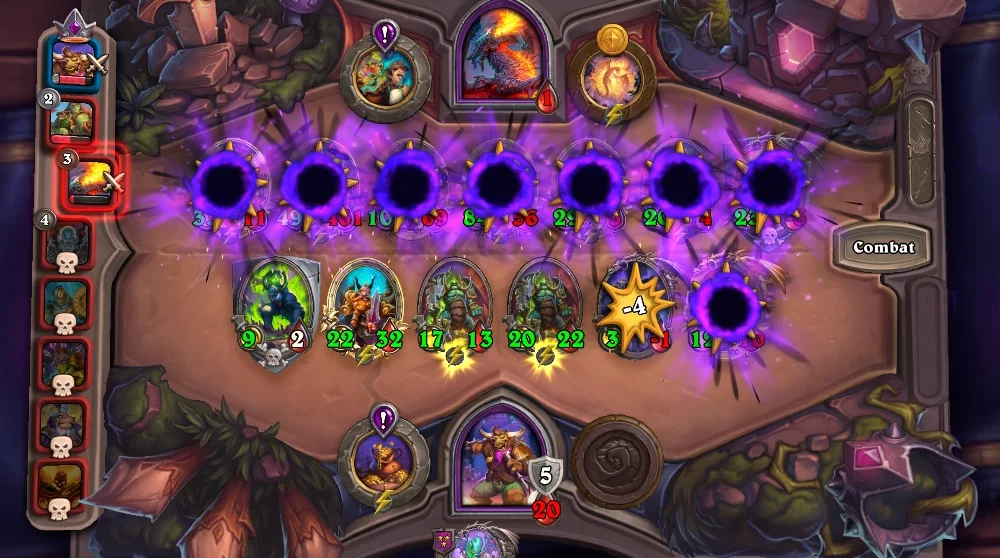
Late game: In the late stages of the game, you will have a very established build, either with Tavern stat gain or with the Silent Enforcer plus Lords of the Ruins combo. And you will need to optimize your board as much as possible. When you already have Lords of the Ruins and Silent Enforcer on the field, it’s very good to get Titus Rivendare, because even though he takes damage from the Silent Enforcer, he also gains stats from Lords of the Ruins and that essentially keeps him alive every time while providing extra deathrattles. This build pretty much resembles early seasons Beast build when you just lay out your Deathrattle and Titus stuff on the board and you’re good to go.
With the “Eats build” there are a couple of nuances. You have the Cupcake Peddler, which works with the Avenger mechanic so it’s pretty good if you keep him in the right side of the board and taunt as many demons as possible on your left side in order to get the precious Corrupted Cupcakes. Of course, he goes very well with Void Earl because you can actually get two Corrupted Cupcakes if you have space, but you really usually don’t have space at this stage of the game because there are a lot of other things that you need to be on the board.
Quests to use for Demon builds
There aren’t especially tailor-made quests for demons, but you still can look out for a few things that go well with them. For example, Perpetual Incantation is pretty good with something like Staff of Enrichment, and Turbulent Tombs are obviously good with your Deathrattle-based Silent Enforcer. Other than that, there are quests that are decent, but not extremely particular.
Strategies for countering Demon build
Once it reaches the endgame, Venom minions like Bile Spitter will be pretty effective, since Demons can’t really get Divine Shields easily in this season.
Spells to use for Demon builds
Generally, Corrupted Cupcakes is a Demon-specific and only if you are playing the “Eats build”.
Murlocs: Mycologist Spell Chaos Build
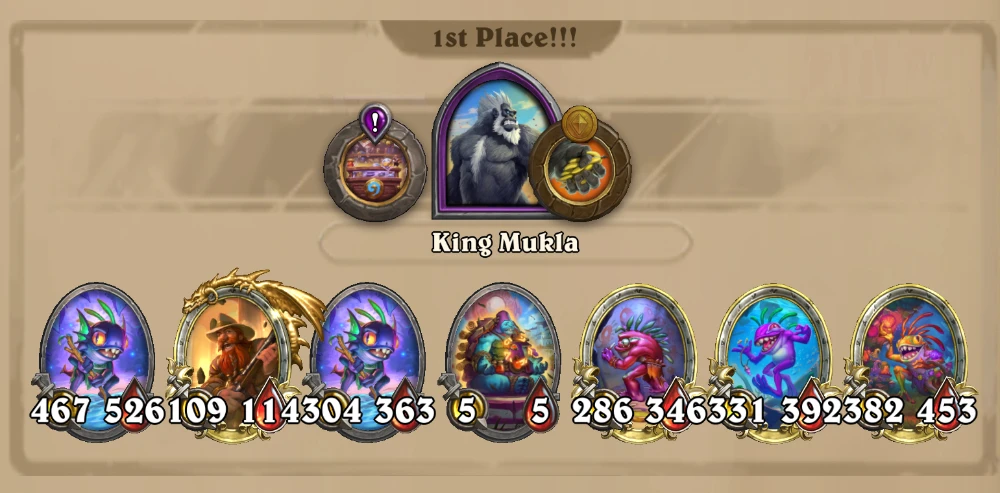
Key minions: Brann Bronzebeard, Magicfin Mycologist, Floatsome Flinger
Supporting Minions: Primitive Painter, Coldlight Diver, Bile Spitter, All-Seeing Elder
For more info on each Murloc minion, check out our full Murloc tribe overview.
Concept: Murlocs in this season have a lot of new changes, and pretty fun and interesting mechanics as far as we are concerned. The main thing to point out is that Murlocs were extremely strong on the season release patch, but in the most recent patch (33.2.2), they were nerfed, and although they are still viable, they are a bit more difficult to get up and running due to the changes in the 33.2.2 patch.
Early Game: In the early game, Murlocs are kind of awkward, to be honest, and they should generally be avoided. For example, Canopy Swinger is nice, but only if you have 3 or 4 Murlocs at your disposal. The same goes for Hot Springer. The ones you need to look out for are Coldlight Diver, which gives you a bit of resource generation, and Adaptive Ancestor, which gives you a bit of a tempo. Other than that, these other Murlocs are pretty generic in terms of strength.
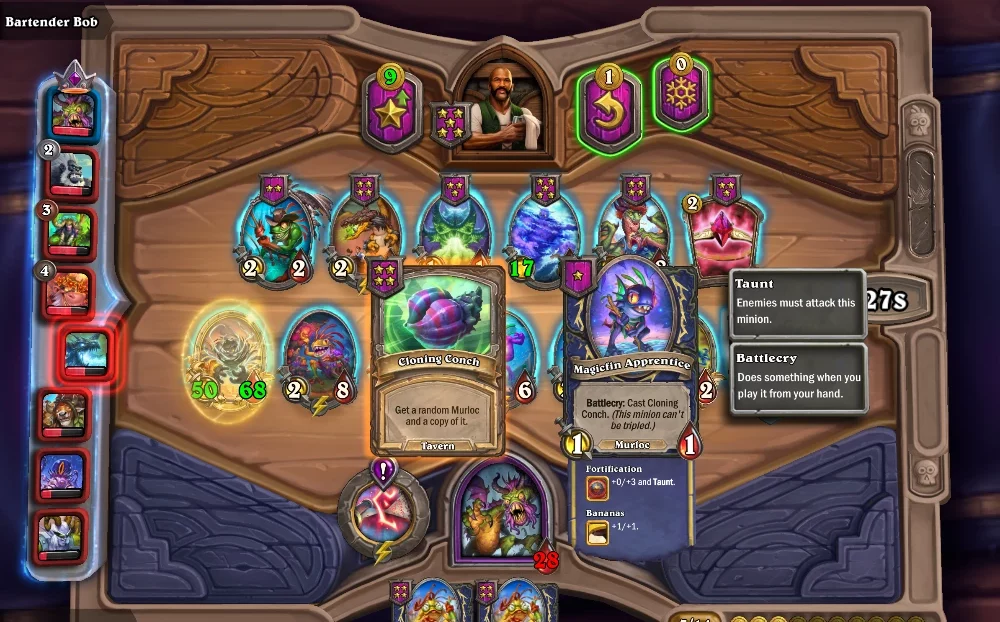
Mid game: In the mid-game, there are a few things to look out for. In this guide, we’ll primarily focus on Battlecry Murlocs because they are the bread and butter in this season. The “Hand Murloc” are kind of a complementary asset. In the mid-game, you will need to get either Brann Bronzebeard or Floatsome Flinger to combine it with Coldlight Diver. And other Tier 3 or below Battlecry minions. This will give you enough resource boost in order to get to the next stage of the game. At this stage, you really need resources. And the best way to do that is with Floatsome Flinger and Brann.
Unfortunately, Murlocs received a pretty significant nerf on their primary new minion: Magicfin Mycologist. He is essentially the bread and butter of your army. This guy will carry you the whole game, especially if you have Brann and Floatsome Flinger. Once you buy Magicfin Mycologist, the next spell you buy once per turn generates a Tier 1 1/1 Murloc that have the Battlecry to play that spell. If you have Brann on the field, then that means that spell will play two times. This also goes well with the combination of Floatsome Flinger, since that Murloc that has the Battlecry of your spell is Tier 1.
So, for example, you can buy Strike Oil, and if you have Brann, your Murloc that you get from Magicfin Mycologist will cast Strike Oil two times, as well as you having the actual spell in hand. This will propel you to victory, and the one spell especially that you need to look for is Cloning Conch. The same logic applies here. If you buy it and you have Brann, you get a Murlocs, and when you play that Murloc, you essentially get two times two Murlocs as well as that spell. So you get six Murlocs out of that spell. It’s pretty good once you get this combination.
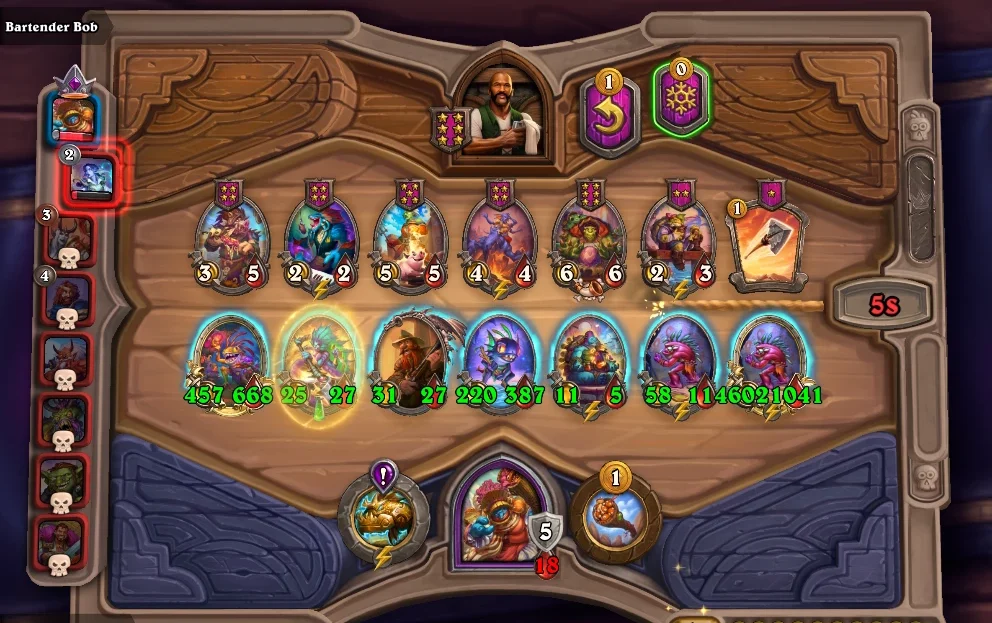
Late game: In the later stages of the game, there are a lot of options to consider if you’re playing the spell Murlocs. You will have to look for at least one, preferably two Magicfin Mycologist and the Murloc-generating spell. Once you get this, the floor is yours, and you can probably go infinite, especially if you have Brann. There are a few tips on optimizing the build, but Primitive Painter, the new Murloc, goes with this build extremely well because you will get a lot of junk and shuffles that you need to sell, and that will give your Murlocs a lot of stats. Once your Murlocs have stats, you will see that your board is a bit crowded, and once it gets to that stage, you can buy something like Channel the Devourer in order to devour the less useful Murlocs and get a few Murlocs with a lot of stats. Once you do this, you can utilize the new Neutral Minion All-Seeing Elder to capitalize on these extremely high-stat Murlocs.
Of course, you can also utilize hand murlocs with Bassgill and Bream Counter, since you will be getting a lot of murlocs this way. And you can, of course, get a golden Bassgill, for example, and two Bilespitters in order to have that nasty late-game scam mechanic in place. Since there are a lot of spells, and it’s pretty RNG on what spells you get, this Murloc build is extremely flexible and chaotic, but the general guideline is to get the setup first, then Cloning Couch for a lot of Murlocs, then shuffle and gain stats with Primitive Painter, then Channel the Devourer some less useful Murlocs to clear the board and setup for All-Seeing Elder.
You can also, for example, if you have a lot of stat gain from getting Shoalfin Mystic, you can buy spells like Azerite Empowerment in order to gain stats, because if you’re really infinite, you have to optimize the stat gaining and to play as fast as possible. All in all, a very good build once you get it up and running, but you have to “get there” first.
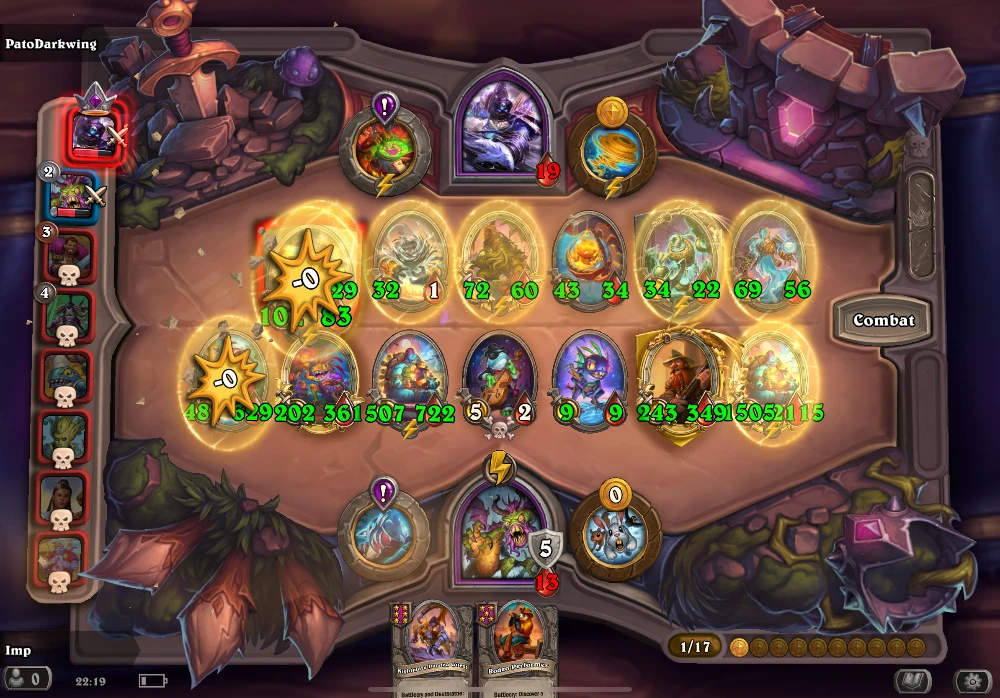
Quests to use for Murloc builds
There are two quests that naturally go well with Murlocs. The first one is Magicfin Relic, which is just a perfect addition to your Murloc build and will essentially lock you into playing Murlocs, probably. The other one is Snicker Snacks, because just as in previous seasons, Murlocs have a lot of Battlecries. Other than that, a lot of other quests are decent, but not extremely particular to Murlocs.
Strategies for Countering Murloc Build
Countering murlocs is extremely difficult because there is a lot of stuff going on on the murloc board. The one thing that you really need is a lot of Divine Shields because you’re going to be playing against venomous murlocs that can also be pretty big stat-wise. So stack up Divine Shields as much as you can and hope for the best.
Spells to use with Murloc Build
Note that in Hearthstone Battlegrounds season 11, the Cloning Conch has returned. This was an important spell for Murlocs, and it’s important to keep in mind when, for example, going for spell-generating trinkets. Getting Lost Staff of Hamuul is also an excellent choice since, just like with Pirates, when you are playing Murlocs, there are a lot of Murlocs that you can find that are useful.
Undead: Not so Friendly Carapace Build
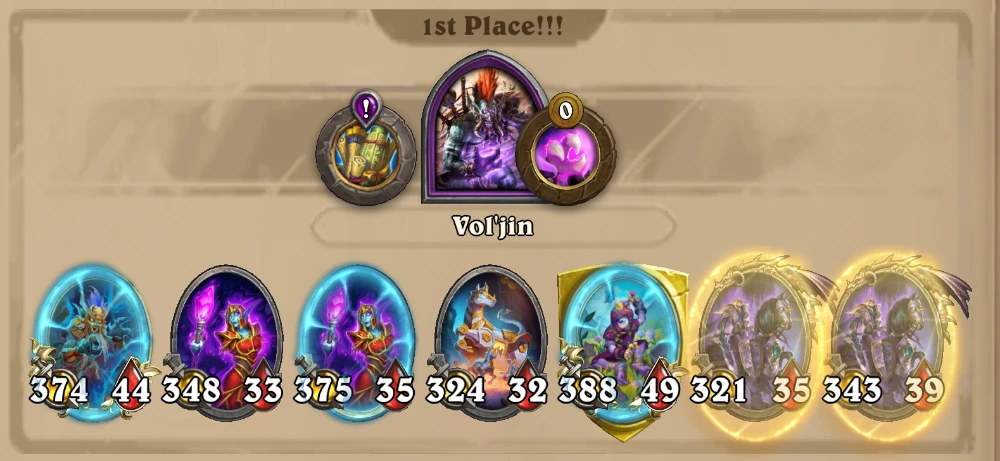
Key Minions: Friendly Geist, Carapace Riser
Supporting Minions: Mummifier, Handless Forsaken, Drakkari Embalmer, Titus Rivendare, Mechanized Gift Horse
Concept: The general idea of this build is to have Friedly Geist buff up your Attack Spell Damage, and then for Carapace Riser to give you Haunted Carapace. Haunted Carapace lasts 1 turn, so you need to either manage it, or make sure you get it after each battle. Remember that the Haunted Carapace spell works on reborns, so all your minions that you summon at any point during the combat will have this buff, not only the starting ones. Your Undeads will also have some defense, so they can’t be really destroyed by extremely low level attacks.
Early Game: The general idea is to get some kind of tempo and a quest that gives you a bit of extra resources, like spells or gold. Once you get up and running, it’s important to get to Tier 3 or Tier 4 as soon as possible, but this depends on several factors. You should be focused on getting some tempo and solving your quest at this stage.
Mid Game: In the mid game, you should be finding your key minions that are Carapace Raiser and Friendly Geist. The combination of these two will be your bread and butter for the Carapace build because Geist essentially boosts your Carapace, and Carapace Rider provides the actual spell to you – Haunted Carapace. Once you get this up and running, there are a lot of Undeads that complement these two and some of them are Undead like Titus Rivendare, Drakkari Embamler, or Mummifier, as well as just having Handless Forsaken in order to get the full value of those boosted Carapace attacks.
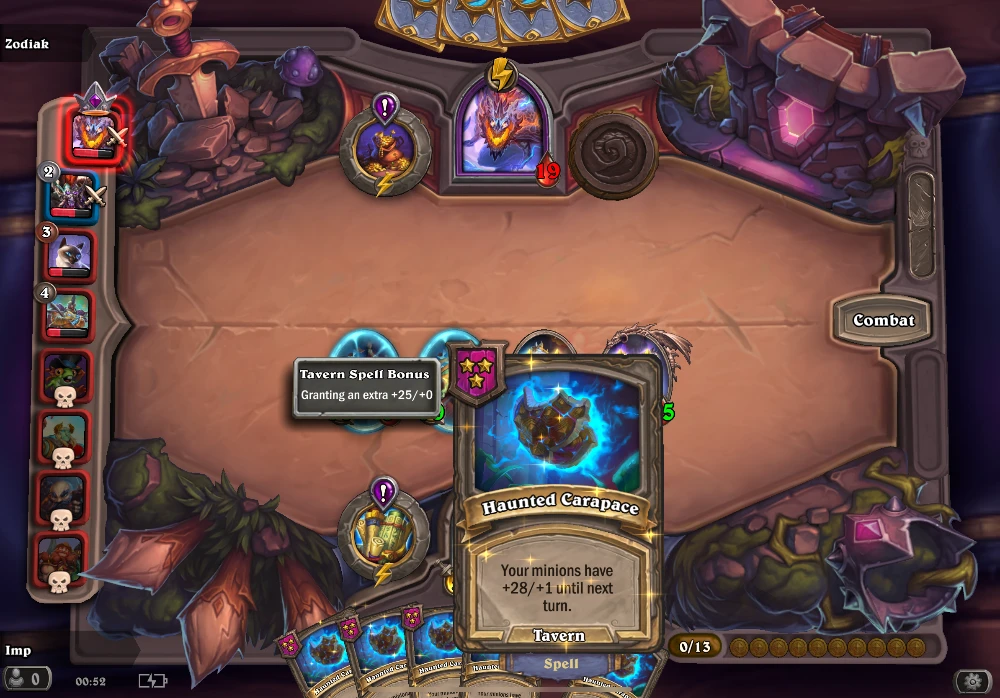
Late Game: At this stage, you should already be producing a lot of Carapace and have a lot of Attack Spell stat built up from the Geist. This is the stage where you optimize this build with Reborns, and minions from other tribes like Mechanized Gift Horse. Remember, do not sell the Carapace Raiser at any point since you essentially rely on him dying each turn to get Haunted Carapace and keep this build alive. Taunt him and make sure he dies every turn. If not, you can actually save 1-2 Haunted Carapace spells in your hand if you are sure your going to defeat your next opponent. That way, you make sure you have it for the battle after the next one. This is a tricky play, but it can be benefitical in certain situations.
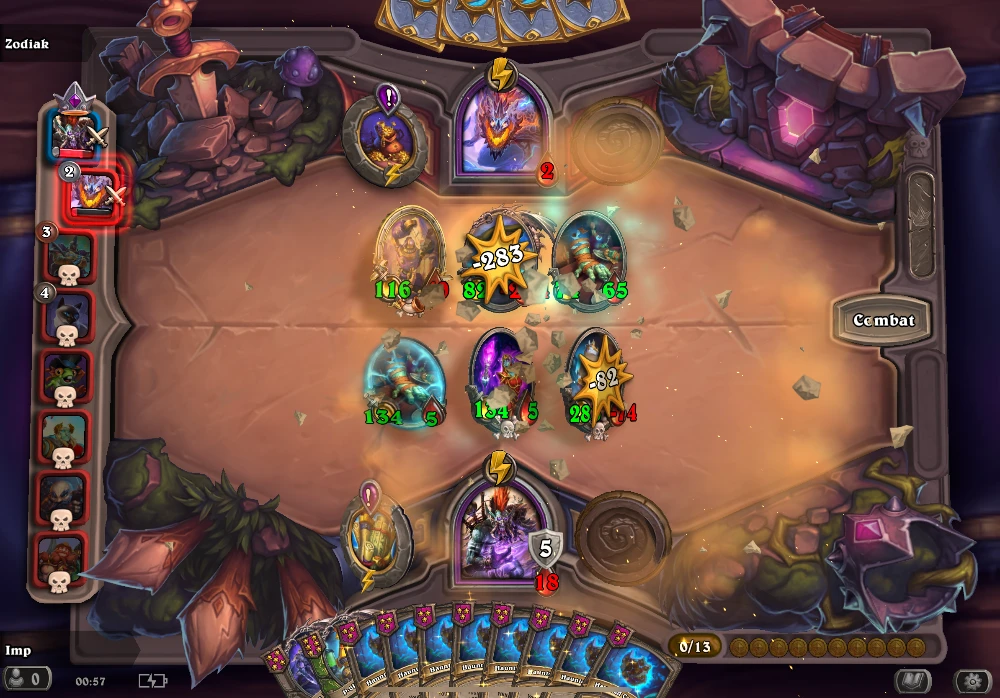
Strategies for Countering Undead Build
Generally speaking, regarding counters, of course the standard counters like cleave and Sin’dorei Straight Shot are nice, and perhaps the best counter is just blasting everything with Silent Enforcer a lot of times so it can die instantly, but other than that, it’s pretty powerful at the moment, and you can’t really counter it so straightly.
Spells to use with Undead Build
Remember that if you happen to get spells that give stats, you’ll of course get the benefit from the friendly geist that gives you attack stat on all your spells, so that’s a really nice bonus. If you get extra free spells like Shiny Ring, that is a nice power boost, but you shouldn’t really spend money on it. rather, you should look for key minions to optimize your board.
Quests for the Undead Build
The best reward that goes well with this build is obviously Turbulent Tombs since everything works with Deathrattle. Other than that, there are a lot of Quest Rewards that give you extra resources, and that is very important for this build. It won’t really produce any resources by itself.
Naga: Tranquil Rogue Build
Key Minions: Rimescale Pristress, Sundered Matriarch, Tranquil Meditative, Wrathscale Rogue
Supporting Minions: Spell-generating Naga’s like Silivaz the Vindicative
Concept: Nagas in season 11 of Hearthstone Battlegrounds have vastly changed – they still depend on spells, but the whole concept of how we buff our minions is different. There is a new concept that relies mostly on Rimescale Pristress and Tranquil Meditative. The main premise is to buff up your defensive capabilities on spells (both Spellcrafts and Tavern Spells) through Tranquil Meditative and then utilize the defensive capabilities by turning it into offensive ones through Wrathscale Rogue. Sundered Matriarch as well as Rimescale Pristress synergize with this battlegrounds build a lot. This is a high-tier build that focuses on spells, and as such, you can utilize other minions that contribute to spell builds (such as Dragon minions).
Early game:
Early on, players should avoid getting low-tier naga minions, as we don’t need them for this Naga comp. The thing is, the only useful low-tier minion is Greedy Snaketongue as this minion is great for tempo and economy boost. Players should focus on building up defenses and getting enough sustain in order to stay in the match. There are no synergies between low-tier Naga units so that’s another reason why you should avoid them. The previous build focusing on Deep Blue scaling is just too slow in this battlegrounds meta, so there is no point in getting Zesty Shaker unless it’s just for a tempo boost.
Mid game:
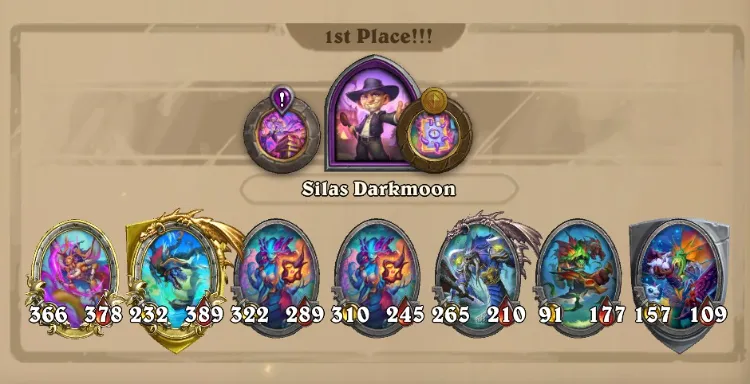
In mid-game, players should focus on getting key Tier 4 and especially Tier 5 Naga units. Obtaining Rimescale Pristress and Tranquil Meditative is a must in this phase, as these two will provide a tempo boost in order for a player to survive and make a decent battlegrounds naga comp in this phase. Getting a Corrupted Myrmidon early on is also a good idea, as this minion can be a real powerhouse later on in the game. Besides, low-level spells can buff this minion up pretty decently so he will be useful in mid-game as well. Firescale Hoarder, on the other hand, is a niche minion, and it does work well, but only with Brann and certain Dragon minions. The good thing is that the players don’t need any of the “big three” minions for this build (Brann, Drakkari, or Titus), so we can just focus on Naga minions.
Late game:
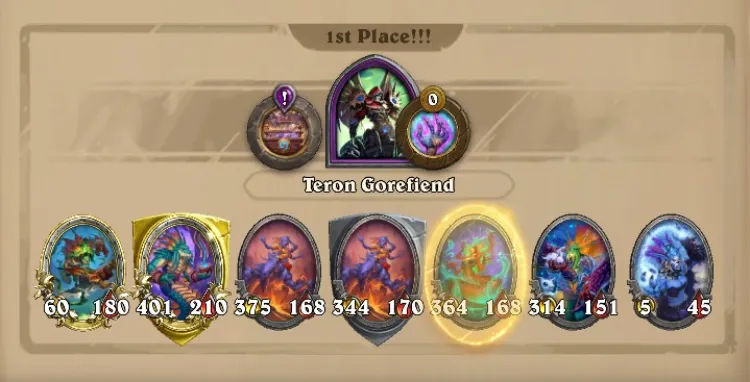
In the late game, getting and utilizing Wrathscale Rogue is a must. Providing that the spells have been buffed by Tranquil Meditative, this minion will give a huge necessary boost to the offensive capabilities of this Naga Battlegrounds build. Furthermore, using Fauna Whisperer and Silivaz the Vindicative is also an option as these two minions also generate stat-boosting spells. The good thing about this build is that, when you set it up, there aren’t many things that you need to do – you just buff your minions in each turn and shuffle through the Tavern looking for useful spells.
Quests to use for Naga builds
Since this HS BG build focuses mostly on spells, using a quest that gives you a spell boost is a good idea. Also, since this build is not strong early on, using any kind of Quest that can provide tempo in mid-game is also a good tip. Furthermore, you should avoid very late-game Quests that are difficult to solve, as the chances are that you will be thrown out of the game before you manage to complete the quest due to the low stats that low-tier Naga minions have.
Strategies for Countering Naga builds
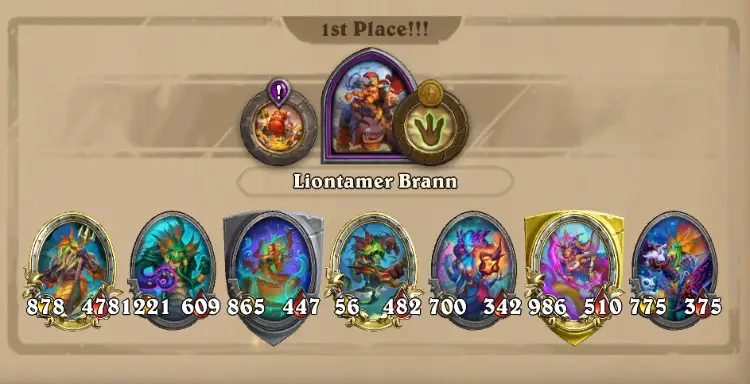
This build is a stat build – so any build that counters stats is to be used against it. This means that you can either go with Poison (there are almost no Divine Shields in this build) or use classic scam with Leeroy. Furthermore, using a build that focuses on Divine Shields is also an option, as Naga comps don’t have any cleave or mass damage minions to counter it. The main issue with countering this build is the fact that most of the time, stats will be divided almost equally among all Naga minions. This means that you can’t just snipe one or two units, so you need to take this into account when countering the build.
Spells to use for Naga builds
As we mentioned before, this is a stat build, and all Spells that give mass stat boosts are to be used in it. Getting a few economy ones is also a good idea, especially early on. Later on, you can stuff like Spitescale Special in order to further boost your spells.
Dragon: Persistent Charmwing Build
Key Minions: Blue Whelp, Persistent Poet, Twilight Watcher, Vangeful Protector, Charmwing
Supporting Minions: Timecapn Hooktail, Thousandt Paper Drake, Nimble Hatchling, Fire-forged Evoker
Concept: The basic concept of the Dragons in Season 11 of HS BG revolves primarily around their Rally abilities and focus on Defense and Divine Shield. This is the main premise that every Dragon build follows. There are several ways in which we can buff up our Dragons – we can either go with Spells and Blue Whelp or we can go with Vengeful Protector and Twilight Watcher, and focus on Rally abilities that give buffs. Windfury is a must in both cases. The newest addition to the Dragon army in season 11 of HS BG is Charmwing – this unit is used in both builds as its ability to transfer defensive capabilities to other minions can scale rapidly. Having a Persistent Poet is also a must, as you want your buffs to stick. The only build that doesn’t require Poet is the one that focuses solely on Firescale Hoarder and spells but this build is a very niche one and is not in the meta right now.
Early game: Dragons are strong in the early game. However, we don’t need to focus on goldening them (except for Blue Whelp) as you won’t need them later on. The main thing to look for is the Blue Whelp, even if you don’t plan on going for the Dragon build. This minion can be useful in other builds and comps as well – for example, Murlocs. Thousand Paper Drake and Sleepy Supporter is a super strong combo to go for early on – plus, the Drake will be useful later on when you get Persistent Poet.
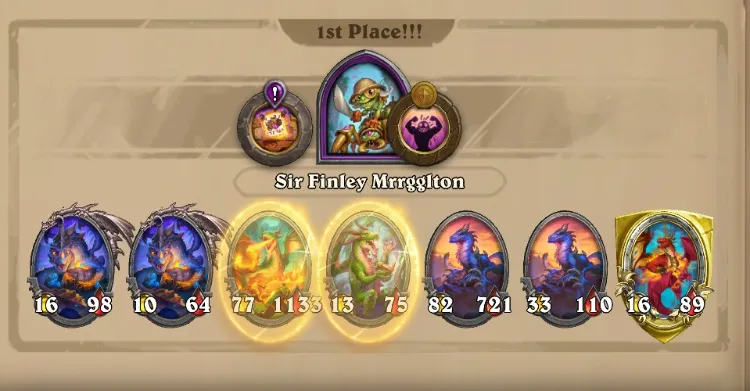
Mid-game: Mid-game is the moment when Dragons are the weakest in the game. This comes mainly due to the lack of any kind of offensive capabilities. Obtaining Persistent Poet at this phase is a must as you need to build up your minions’ strength in order to survive until the late phase of the game. Also, the new dragon unit, Twilight Watcher, is a great tempo minion as his abilities work perfectly with Windfury. Using Tavern Spells at this phase is also a good investment, especially if you can’t build up your army’s strength in a different way or if you have a Quest that allows you to do so.
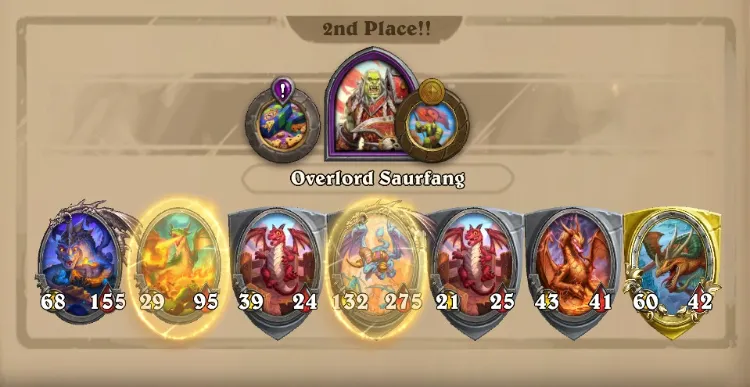
Late game: In late game phase, Dragon comp scales rapidly. Most of your units will have Divine Shield capabilities, and casting Spells with Fire Forged Evoker provides a decent tempo. However, Charmwing is your key minion in this phase – he needs to attack twice, preferably with Divine Shield on him in order to cast defense stats on other minions several times. There is an RNG moment in this phase as you want the stats to be cast on minions adjacent to (golden) Persistent Poet so that they become permanent. In order to do so, pay close attention to the order in which you line up your Dragon army.
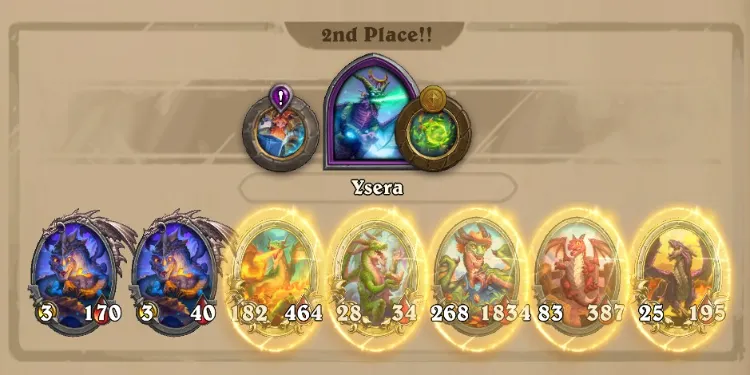
Quests to use for Dragon builds
The main quests to look for are the ones that are easily solvable and provide decent tempo. Also, since Dragons don’t have any economy minions, using Rewards that give you gold is also a good option. Basically, you don’t need any Quests that give stats, as you will get stats from your build if you assemble it correctly. Also, Divine Shield is not really advisable unless it goes with Windfury, as you will have Divine Shield anyway. You also don’t need any Battlecry or Deathrattle quests as this Dragon build in season 11 of Hearthstone Battlegrounds doesn’t use any of those keywords.
Strategies for countering Dragon builds
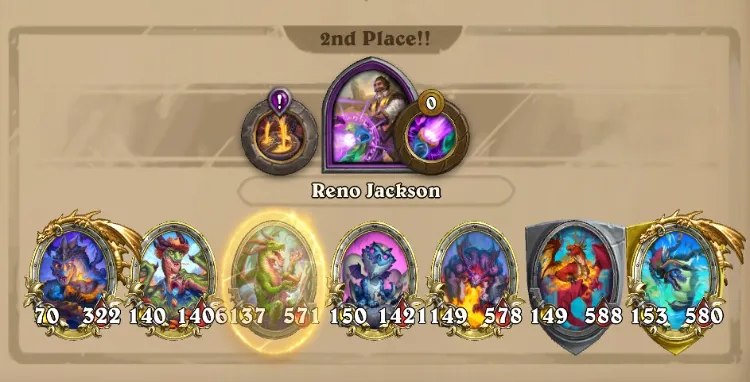
The first thing you need to do is to take down the Divine Shields that the Dragons have. If you manage to do so, any unit with Poison is a good option to go for as Dragons don’t have any Reborn capabilities. Using a scam is also a good idea in this way. Keep in mind that Dragons will have Windfury capabilities, probably more than one minion, so try to use Taunt on your minions that are not the key ones for the build.
Spells to use for Dragon builds
Tavern Spells that boost your stats and economy spells. Those are two types of spells to go for when playing Dragon comps. You don’t need any other kind of Spells as your whole build will work perfectly if you manage to buff up your spells to a decent level.
Elemental: Ultraviolet Lava Build
Key Minions: Brann Bronzebeard/Tavern Tempest/Lantern Lava (Resources), Ultraviolet Ascendent (Scailing)
Support Minions: Ichoron the Protector, Dancing Barnstormer, Fire/Snow Baller, Elemental of Surprise
Concept: Elementals have had a fundamental change this season, and a lot of new minions have come into the rotation. Their main strategy is still kind of similar to before, and that is to cycle a lot of minions and get more elementals via various effects. The new mechanics that elementals have this season are with “when you sell this elemental X thing happens”. So this effect sets up the whole premise around cycling minions, and then at the end, having a lot of stats and Divine Shields.
Early game: In the early game, you really shouldn’t be focusing too much on minions like Dune Dweller, Snow Baller, and Fire Baller, because those are minions that are used later on when you start to cycle everything and when you have much more resources. The primary minion that you can buy here is the Bountiful Bedrock, which is a very decent minion that will give you a random elemental every 3 turns, and it’s generally a good value, especially if you’re trying to play elementals in the current lobby.
Mid game: Elementals in the mid-game don’t really have a lot of tempo because most of them are still reliant on cycling. Sure if your Tavern is “forcing” Elementals it is fine, but they should generally be avoided because there are a lot of other different ways of getting tempo and resources at this stage of the game. The star of the show here is the Lantern Lava, and Tavern Tempest which gets you a random elemental on the Battlecry, so it works with a lot of stuff like Brann Bronzebeard. Playing around this card and if you manage to golden a Bountiful Bedrock, it should be a good baseline to generate more Elementals and start cycling. However, the main idea is to utilize Brann as much as possible because you can play Tavern Tempest, sell it, get another one through Lava Lamp and play it again. Just by doing so you get 4 random Elementals. Keep in mind that Lantern Lava will give you a double minion if it’s golden so that should be one of your goals as well. Vine Climber is a decent tempo minion that you can use in this phase as well, especially if you have Lantern Lava on the board.
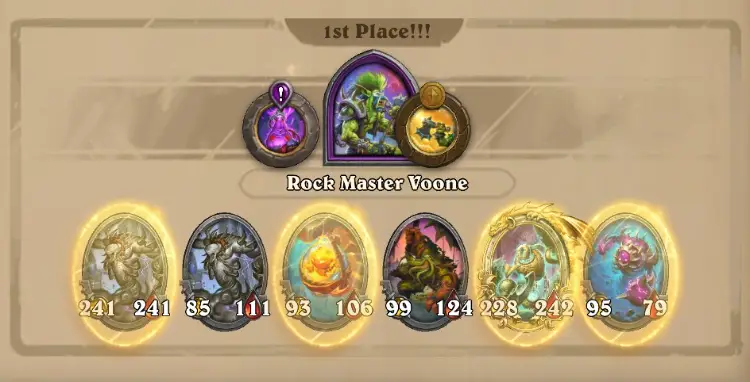
Late game: In the late game, the primary focus, as we already said, is on cycling mechanics. In case your Tavern is buffed up you can go with Carbonic Copy as well, although there are alternatives that are stronger than this minion usually. At one point, you can sell Brann as well. The main minion to look for is Ultraviolet Ascendant. The main idea is to gain a lot of Tavern, as well as board, and then top that all off with Ultraviolet Ascendant’s Start of Combat ability. Everything scales with how many Elementals you played and how much you sold certain Elementals. That’s why this build only works if you’re actually cycling a lot of stuff. You will also gain a lot of stats from Fire Baller and Snow Baller. Of course, there’s still Elemental of Surprise to gain you a permanent Divine Shield by tripling something. The other new way to get more Divine Shields is Ichoron the Protector, but remember that he also works only if you cycle minions because the elementals don’t get to keep the Divine Shields once played.
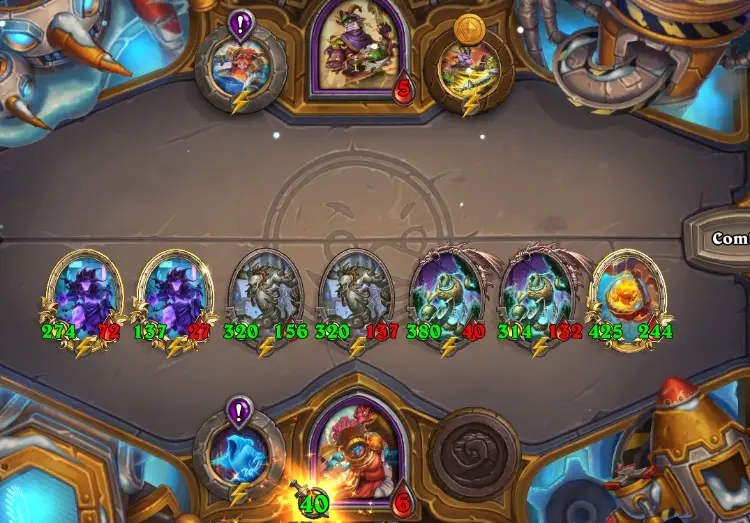
Quests to use for Elemental builds
Generally speaking, you want to get a good tempo as Elementals will be very weak in mid-game, before you get Brann. Utilizing any kind of economy or trinket Quest is advisable. You don’t need any spell boosting abilities as you don’t need basically any spells for this build. All you need is to get the Lava Lamp, Brann, and Twilight Ascendency, and that’s it – your quest choices should align with that strategy.
Strategies for Countering Elemental Build
Currently, there aren’t really straightforward ways to counter elementals because if your opponent has elemental minions, they will probably have a lot of divine shields and a lot of stats, so you can’t rely on scams like Venomous minions. You will just need to knock him out earlier or outscale him with your own board. One thing you can do is if your board doesn’t have Divine Shields, you can blow up theirs with Kaboom and then equalize the playing field a little bit.
Spells to use with Elemental Build
The one spell that you can really use is the Temperature Shift, which is precisely for this build, as it gives you a Fire Baller and a Snow Baller. Other than that, Channel the Devourer can be pretty helpful in a lot of situations involving cycling.
Pirate: Screeching Eudora Build
Key Minions: Ship Master Eudora, Titus
Supporting Minions: Monstrous Macaw, Lightfeather Screecher, Thieving Rascal
Concept: Pirates in Season 11 of Hearthstone Battlegrounds are not in the current game meta. The thing is, builds that resolve around Pirates are very slow and require many key minions in order to work properly. There are two builds that are possible when it comes to Pirates: The one focusing on Golden minions and end-of-turn effects, the one focusing on Bounties and this build, focusing on Deathrattle and Eudora. This specific Pirate comp resolves around two things – Ship Master Eudora ability to give permanent stat boosts on Golden Minions and Macaw+Titus+Screecher combo to activate that Deathrattle effect several times. Having Goldgrubber and Thieving Rascal is good for tempo and economy, but it’s not a must, especially depending on what kind of Quest or Trinket you might get. Lets see how Pirates work in season 11 of HS BG.
Early game: Early on, you don’t need to buy any Pirates for this build; however, it’s always advisable to utilize Economy minions such as Southsea Busker and Freedealing Gambler early on. Even Goldgrubber is not a must in the early phase – one does not decide to go for pirate builds, that’s just something that RNG needs to do as your key minion is Ship Master Eudora, a Tier 6 minion. Without it, it simply won’t work.
Mid-game: In mid-game, try to get Thieving Rascal and some golden minions to boost your economy. However, keep in mind that your Pirates will be very weak, and you need to get some sustain in order to survive until you get Eudora. The best way to do this is not to assemble pirates at all – get some Rally minions or whatever is strong in the Tavern and try to golden in. On Tier 5, you can find Yorik Smite as well who can provide some tempo for the build, although you won’t need him for very long.
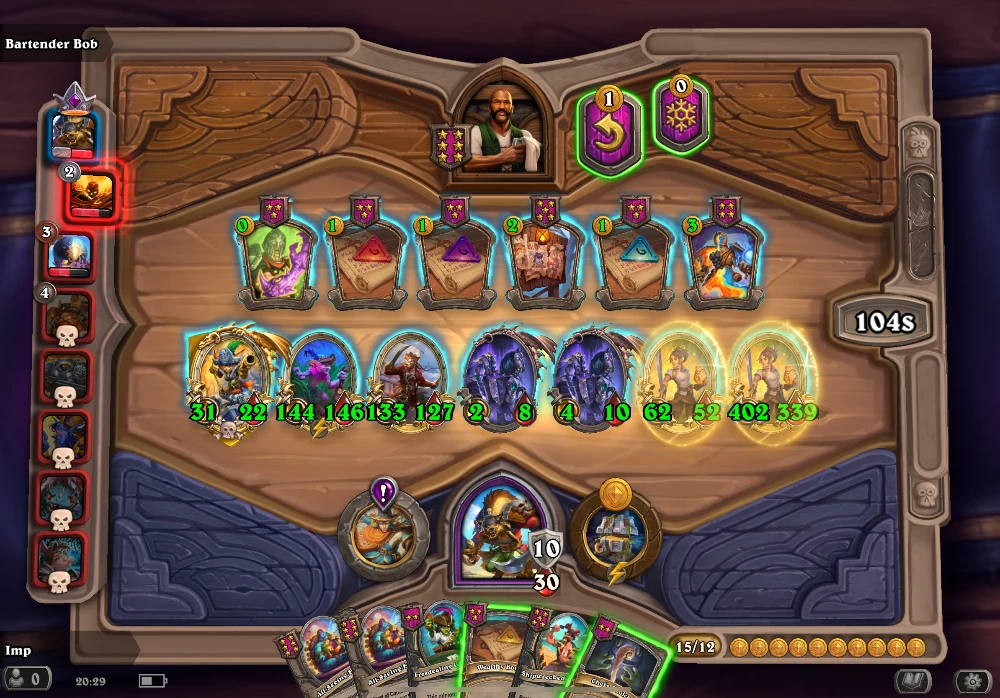
Late game: Late game is when the party starts for the Pirates – you will have tons of gold and try to golden all your minions. This is your main goal – unlike other builds, you don’t need to shuffle minions as there are no Battlecry or any other play-a-card effects in this build. You need to find Golden Titus, golden Macaw, golden Ship Master Eudora so pretty much everything needs to be Golden. Even then, most of your minions will still be vulnerable to poison and won’t have any keywords other than Deathrattle: give stats. Good luck!
Quests to use for Pirate builds
When it comes to Quests, the best thing to use are the fast Quests that can provide sustain. If you go with any high level quest and are not insanely lucky to get Eudora early on, you will simply lose the game as the tempo is just horrendous for Pirates in this Battlegrounds meta. Spells, economy boosts, discover Quests – whatever helps to survive mid-game is a viable option.
Strategies for countering Pirate builds
Basically, Pirates in best-case scenario will have high stats and one Cleave minion. Because of Cleave, put Taunt on your weakest minion and move it to the far right side. When it comes to stat problem, most builds will successfully just outgun Pirates, but in case you still have problems, you can go with any Poison or scam minion that you can find since Pirates don’t have any Divine Shield options.
Spells to use for Pirate builds
When it comes to Spells, you can utilize Bounties but don’t relly on them. Most of the Bounties just give a small stat boosts, and that won’t be enough – focus on Economy and Discover spells in order to quickly gain Eudora and move to Tavern Tier 6.
Quillboar: Bonker Warlords Build
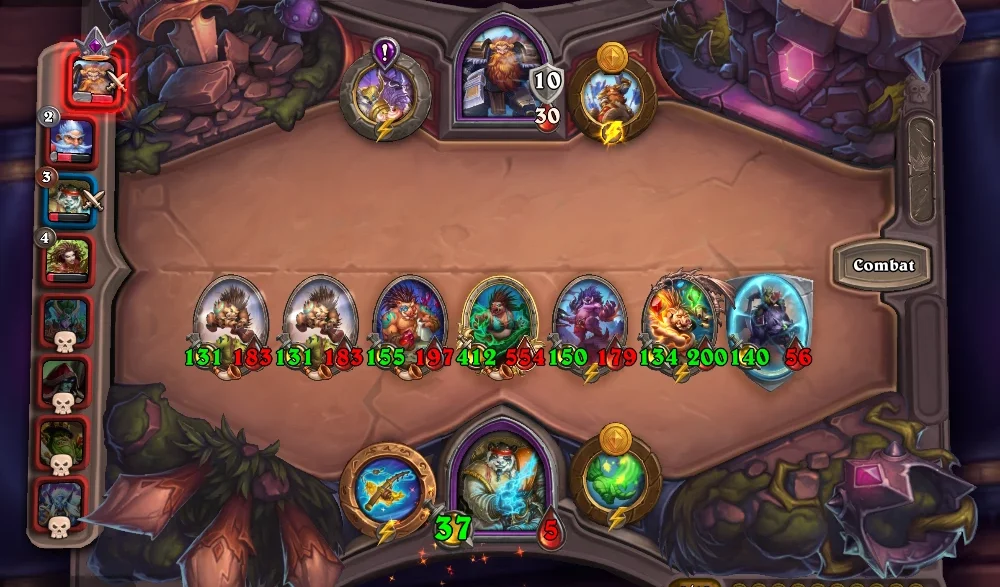
Key minions: Bloodsnout Warlord + Bonker (Rally Gem Generation), Brann + Gem Smuggler (Battlecry Gem Generation), Roadboar + Hot-Air Surveyor (Hand Gem generation), Chargla + Drakkari (End of Turn Gem Generation
Support minions: Sanguine Refiner, Prickly Piper, Moon-Bacon Dresser, Fearless Foodie (Gem Stat Buff)
For more info on each Quillboar minion, check out our full Quillboar tribe overview.
Concept: The essence of Quillboars in this season stayed the same, with a few caveats regarding the Rally mechanic. You essentially need to buff up your gems in some way, and there are a few ways to do that. And then you can either go with the end-of-turn Quillboars, Battlecry Quillboars, or the most powerful ones, and the newest one – Sanguine Refiner. Essentially, everything revolves around getting Blood Gems – buffing Blood Gems, and playing Blood Gems on your Quills. So nothing new here. The core stays the same.
Early game: In the early game, you have to be careful of managing and going for Quillboars. For example, Glowgullet Warlord is a pretty good tempo minion because you essentially get three 2/2 minions. And Prodigious Tusker is good if you have other rally minions. Early on, try to boost economy and survivability as much as you can since you don’t need to focus on Quillboars. However, once you upgrade to Tier 3, you will need to start buffing your Blood Gems, and getting Prickly Piper is a must-have. In this season of HS BG, there aren’t many ways to buff up the gems – pretty much only four: Prickly Piper, Moon-Bacon Jazzer, Fearless Foodie and the new Rally Quillboar – Sanguine Refiner. Since Piper is the only low-tier minion worth taking early on, focus on getting him, but also don’t rush it, as you really want to have some defenses up in order to get the right tempo. Keep in mind that Quilboars do need time to show their strength – it is one of those tribes, similar to Elementals, that need to take a beating for a few rounds before becoming strong enough to take down opponents.
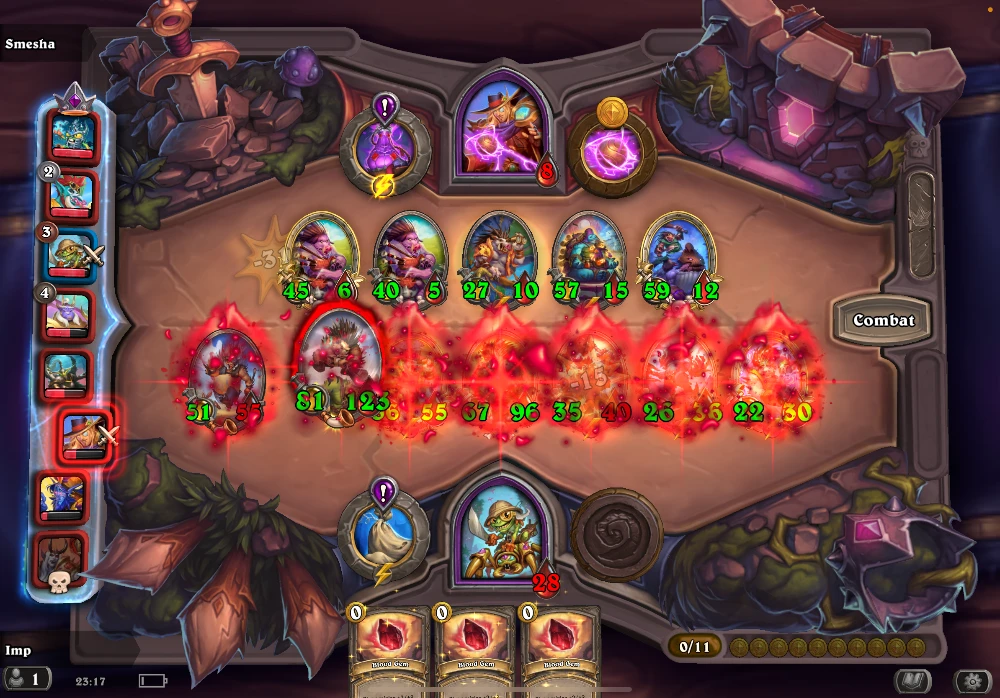
Mid game: In the mid-stages of the game, you will have to focus on getting your blood gems buffed with the mentioned Fearless Foodie, Moon-Bacon Jazzer, Prickly Piper, or Sanguine Refiner. All are pretty good, and you generally need some tempo. They also buffed Gem Smuggler in this recent patch, and the buff is pretty significant; it’s essentially double. You play 2 blood gems on all your minions, and the golden one plays 4, so it’s extremely powerful, but only if you have a bit of buffed gems.
Generally speaking, you will want to get, again, stat gaining on Blood Gems, as well as generating Blood Gems. There are a few choices here, but generally, you can’t really choose what quill you get, you will just have to buy the RNG one from the Tavern. So, there are a few ways to play this build, like, for example, Hot-Air Surveyor is a good quill, but only if you get actual Blood Gems in your hand from, for example, Roadboar. But, on the other hand, if you have Razorfen Vineweaver, then Hot-Air Surveyor is pretty useless, because you don’t actually get to play the Blood Gem from your hand on the Quillboars, so its effect isn’t in play. That goes the same if you have Bloodsnout Warlord, so keep in mind that not every Quillboar works perfectly with other Quillboars, and play around with that.
Late game: In the late game, the current best build is either if you have some regular or golden brand, because Gemsmuggler is extremely powerful, but the best build is for sure with Bloodsnout Warlord and with the general Rally build. Having, for example, Razorfen Vineweaver, and Bonker combined with Bloodsnout Warlord and Sanguine Refiner will almost always get you the first three places, because there is just a lot of stuff going on regarding playing blood gems and gaining stats. Of course, Quillboars are not really good at generating resources, so picking up a quest for resources is a nice addition.
Quests to use for Quilboar builds
There aren’t really specific quests that can for example buff up your blood gems or something like that. But getting resource-based quests since you need those extra minions in the later stages of the game. And you can’t really produce extra resources it just by playing Quillboars alone.
Strategies for countering Quillboar build
Honestly, the best “counter” to Quillboars is wiping them out in the midgame. They have these 1-2 turns where they are very weak until they get their buffs and board in order. This is where they lose if they happen to encounter someone with an already “established” build. This is kinda true for every build, but Quillboars especially need this leeway.
Spells to use with Quillboar build
Quilboar comps in Season 11 of Hearthstone Battlegrounds don’t rely much on Spells. Getting Gem Confiscation is a good utility spell for changing up the board, especially if you want to put gems on a Cleave minion.
Mech: Clucky Attack Chicken Build
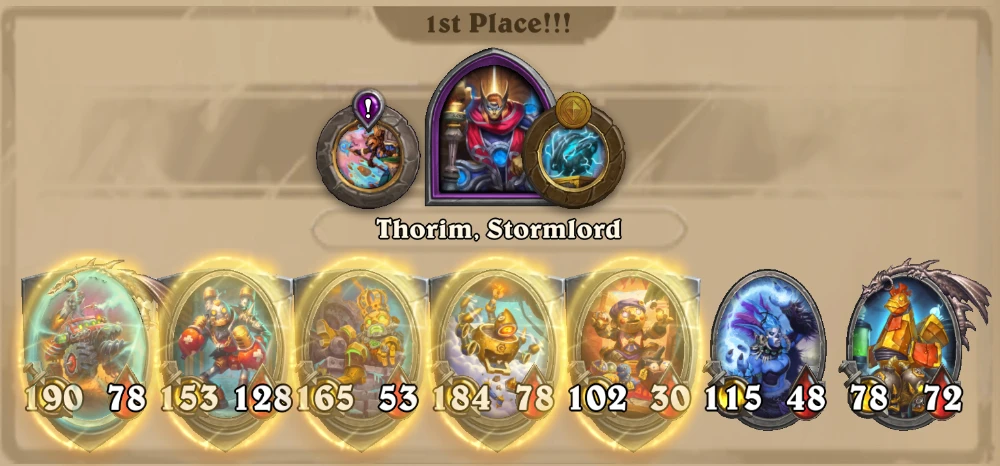
Key Minions: P-0UL-TR-0N, Gleaming Trader, Holo Rover, Polarizing Beatboxer
Supporting Minions: Ruins Renovator, Rickety Repairbot, Whirring Protector, Replicating Menance (Microbots), Annoy-o-Module (Taunt)
For more info on each Mech minion, check out our full Mech tribe overview.
Concept: Mechs are a bit of a weird place right now, and at the beginning of the patch, P-0UL-TR-0N was the new mech that was removed from the game the same day, but now that he’s back, there is an actual viable “Divine Shield-based build”. But there are also new returning Mechs, like Polarizing Beatboxer, which make things a bit more complex, as well as new magnetizations like Whirring Protector.
Early game: In the early game, you don’t really have a lot of stuff going for max, except Geared Guard, which is generally a nice tempo minion with the rally mechanic. You can generally ignore the deflector bots and stuff like that, because you don’t really know if you’re going to get everything necessary to play this build.
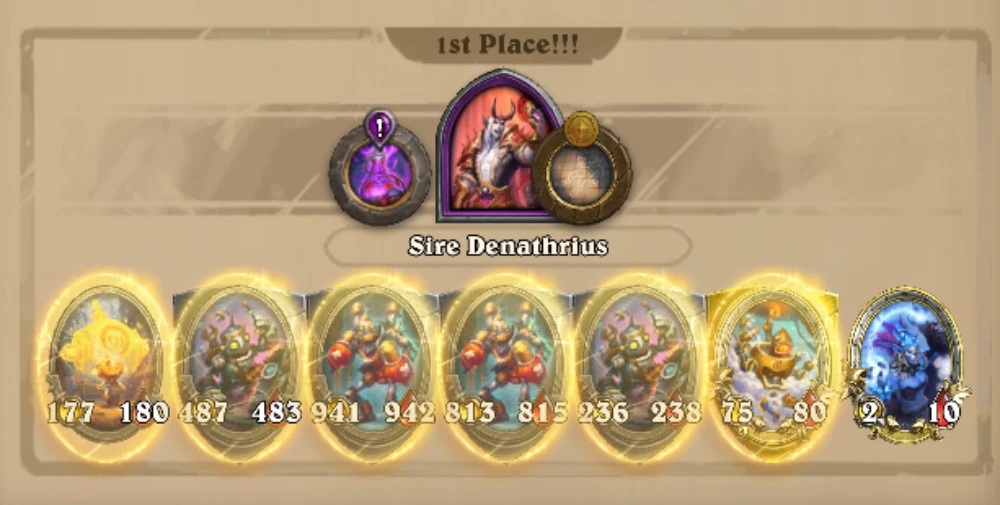
Mid game: In the mid-game, stuff gets a bit more interesting. There are still magnetization-oriented mechs in play, which usually you will need to get the Drakkari Enchanter, Utility Drone, and Rickety Repairbot, but we will be focusing on the Divine Shield builds and magnetizations as a secondary mechanic. The basis of this build relies on you getting Divine Shield minions like Charging Czarina, Ruins Renovator, as well as something like Holo Rover (in order to get extra resources). This is preparing you for the setup of Gleaming Trader and P-0UL-TR-0N, which will be your primary “scary carry minion”.
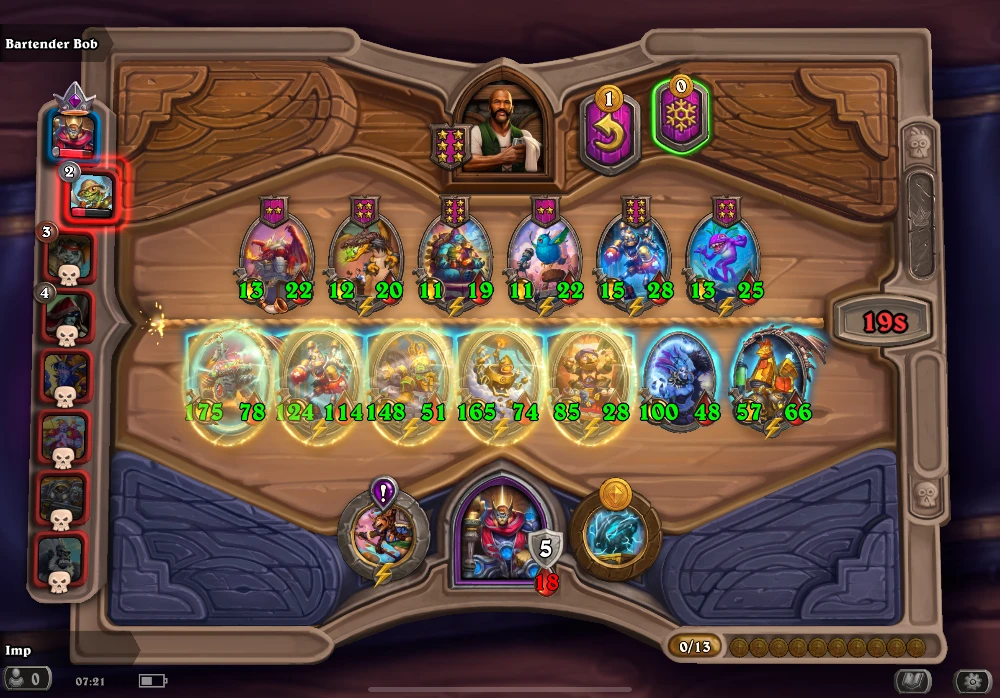
Late game: With Gleaming Trader and P-0UL-TR-0N, you will have an extremely powerful Divine Shield attack build, and you will also need to taunt pretty much everybody except P-0UL-TR-0N in order to get the most out of this build. Of course, there is still Polarizing Beatboxer in play, but while you can go full throttle on the magnetization build, the reality is that you will usually end up with a mix. There is one more new interesting magnetization in this Hearthstone Battlegrounds Season 11, which is the Roaring Protector. Playing this magnetization on P-0UL-TR-0N essentially gives you even more firepower, because P-0UL-TR-0N will attack for every 4 mechs that you lose, and then the Whirring Protector magnetization will enhance the attack of all other mechs.
It’s also worth mentioning that Replicating Menace is now pretty powerful, since the little microbots can get that extra attack, as well as ramping up the Avenge effect on P-0UL-TR-0N. But the general idea is to combine magnetizations with this new mechanic, since you can’t really go infinite anymore with Polarizing Beatboxer and Holo Rover, because there is no gold gaining magnetization.
Quests to use for Mech build
Generally speaking, there aren’t too many quests that are extremely good with this build, but Ghastly Mask can go well with the end-of-turn magnetizations if you have Utility Drone. And spell-gaining quests like Stash of the Scribe are pretty nice if you have a few Charging Czarina in play, because even if you are losing the game, this will get you some tempo and momentum to get the first three places.
Strategies for Countering Mech Build
Mechs are pretty straightforward to counter, and the biggest counter for them is, for sure, Tunnel Blaster. It will blow up all the Divine Shields that are the backbone of Mechs. Furthermore, utilizing Leeroy The Reckless against P-0UL-TR-0N or a powerful Divine Shield mech is a pretty good counter.
Spells to use for Mech Build
There aren’t a lot of tavern spells with max that can provide you with some extreme value, but one notable and most important one is Lost Staff of Hamuul, which is a very good way of getting magentizations/key minions.
Alternative Builds
Pure Spell Builds: Sorcery Engine
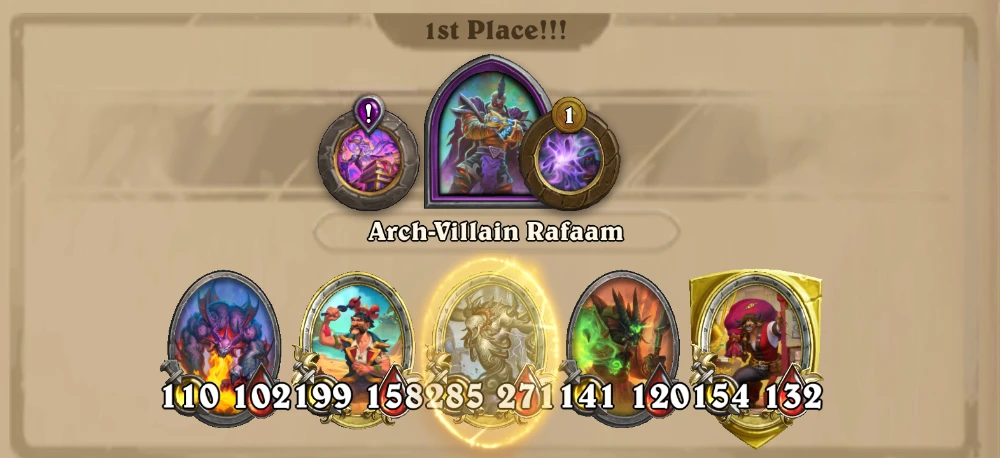
Key minions: Spell-stat Boosting Minions – Felfire Conjurer, Tranquil Meditative, Friendly Geist, Shoalfin Mystic, etc.
Support minions: Spell-generating Minions – Ignition Specialist, Silivaz the Vindictive, Firescale Hoarder, etc.
Spell Quest: Perpetual Incantation, Stash of the Scribe, etc.
We put this build as one of the primary ones because a lot of the time you will be given a pathway into this build and it’s meta, especially for beginner to intermediate players. This is why we put this build almost at the beginning of our Battlegrounds Season 11 guide.
Concept: Okay, so the spell build is probably one of the most complex builds in the current HS Season 11 meta, because there are a bunch of tribes that have potential for this build. The main thing you have to look for is things that buff up the stat-gaining of spells. So, for example, your shiny ring is +1/+1, you can enhance it to be +10/+10. And if you get 10 shiny rings, that means you can get +100/+100 on your whole board. To get to this point, we’ll have to utilize a lot of different minions, and while we do have specific tribe builds, like, for example, the spell build on dragons, there is a distinct difference between going full spells and focusing on one tribe. Since you can’t really predict what you’re gonna get, sometimes pivoting into a spell build is a very good choice. So, for example, if you have an Ignition Specialist and a bunch of spells, and you just can’t get that fire forged dragon, and instead get Humon’gozz, then you’re not gonna play dragons. You will have to pivot into playing a spell build.
One thing you do have to be aware of is that not every tribe has the ability to buff spells, and that is extremely important because if you’re thinking of shifting to a spell build, you will have to look at which tribes are currently in your lobby. Because, for example, if you have Pirates (Bounties can help, but not reliably), Beasts (Rylak Metalhead can help though), Quillboars, or Elementals, then none of these tribes will help you to get the spell build correctly. A good telltale sign to go for this build is if you have Dragons, Murlocs, Nagas, Demons, and Undeads.
So basically, half the tribes have this ability to buff stats, and the other half don’t. Some of these examples are Felfire Conjurer, Tranquil Meditative, Shoalfin Mystic, and also spell-generating minions like Ignition Specialist, Silivaz the Vindictive, Rimescale Pristress, Firescale Hoarder, etc.
Also, there are some neutral no-type minions that are “made for this build”, like Humon’gozz, an extremely powerful minion because it instantly buffs all your spells just by his presence on the board, and on top of that he is a tier 4 5-5 Divine Shield minion.
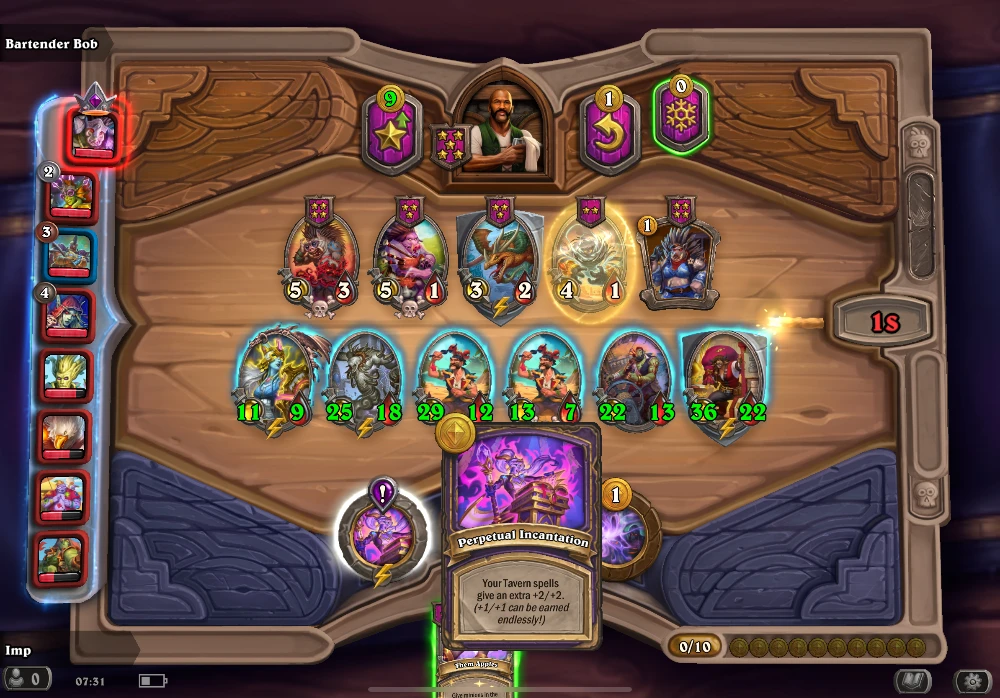
Mid Game: You need to rack up your economy and perhaps pick up a Humon’gozz or two. At this point, you can, for example, find Time Management, then you will cast Time Management twice, so it’s +4/+4, twice. This means you will get +8/+8 on all your minions. This is just a crude example of what this build is all about, and what can it do if you happen to get the right minions. Moreover, this is only the early game tempo, and in the later stages, you will have to set up some stats on the spells and then go for spell gathering minions we mentioned earlier.
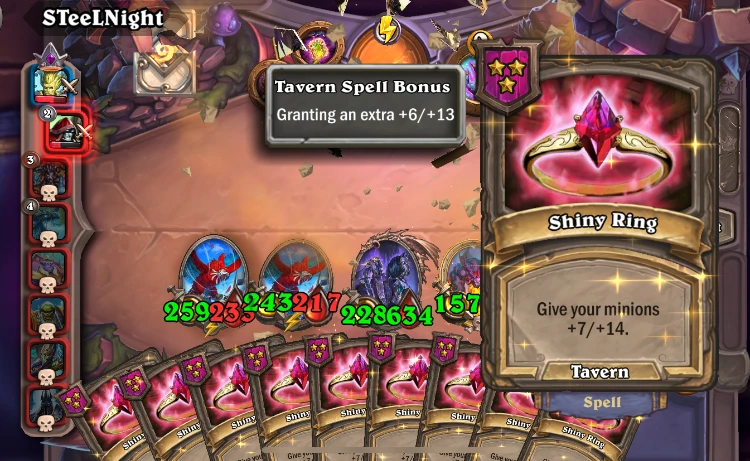
Late Game: Once you have your board set up and stat-gaining minions, you will have to actually scale in an exponential way. One way to do this is by having Felfire Conjurer because it’s with Drakkari, that is probably the best way to get the stats up on your spells. We already mentioned a lot of spell-generating minions in the beginning, but in the later stages, the ones that you have to look out for are Ignition Specialist, Silivaz the Vindictive, and Firescale Hoarder, but there are a lot of other ones that will fill in that void. Also, you can utilize Brann, Titus, or Drakkari with this build, depending on what type of minion you get.
So it’s a really flexible build, it really is dependent on what stuff you get, and that’s not even counting the quests you get. You’ll have a lot of instances where you have a certain board set up with this build, and you want to exchange your minion for another one in the tavern because you think that that may be better. That will happen almost every turn because there are so many things that can go well with this build.
Generally, there were buffs with this build in the latest 32.2.2 patch, especially Shoalfin Mystic. It’s still a solid build.
Undead: Wilted Harvesters Build
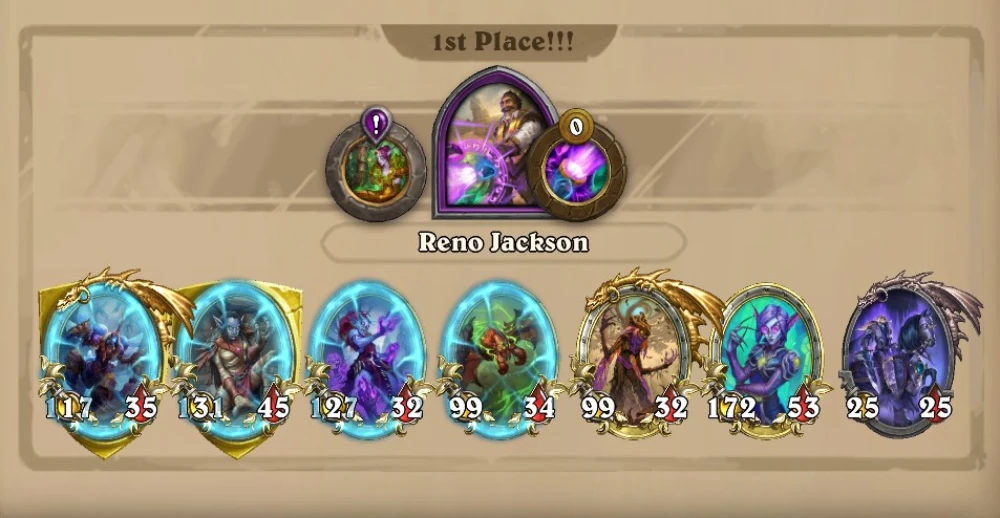
Key Minions: Oranmonos the Wilted, Anub’arak Nerubian King (Attack build)
Supporting Minions: Mummifier, Deathly Striker, Handless Forsaken, Drakkari Embalmer
Eternal Knight alternative: Scourge Harvester, Eternal Knight, Eternal Summoner
For more info on each Undead minion, check out our full Undead tribe overview.
Concept: Generally speaking, Undeads have more or less stayed the same strategy-wise, with a few caveats. You still need to boost the attack and have Reborns in place, and it’s still a third-place build. Of course, there are a few cool new minions that we’ll talk about, and stuff that you can do with Eternal Knight now, but other than that, it’s just more attack.
Early game: In the early game, there is nothing too special about Undeads. But you can get a few Ride or Die or Scarlet Skull with the combination of Jelly Belly, and you can have some tempo at this stage of the game. Moreover, picking up Eternal Knights can be a good idea because you can actually go to the late game with them, if you are lucky, of course.
Mid game: In the mid-game, things get more interesting. The most recent change is that Anub’Arak, Nerubian King, is tier 3, so you can actually get him pretty early and start boosting your attack sooner than later. Moreover, you have new interesting minions like Oranomonos, the Wilted, which works with your Reborn and attack gain. He is the primary thing that you can boost your attack with, because if you trigger 5 Reborns in one battle, that is +5 attack on all your undead. Of course, getting reborns with Drakkari Embamler is also good.
There is actually one very interesting new minion, and that is the Scourge Harvester, which inherits your summoned Undead in combat stats. And he isn’t actually useful with the attack build, because you will just get one 500/30 minion. But if you are actually playing Eternal Knights, and you happen to get the Eternal Summoner, it can get pretty high stats, especially if you have two of these or Golden. That said, you will have to have an early Eternal Knight, and essentially an Eternal Summoner plus this guy, so it’s a build to consider, but you actually need to get all three minions.
Other than that, there isn’t anything too special, because the new Campfire Shadow doesn’t really synergize with undeads, and the Friendly Geist is practically a spell build.

Late game: Of course, Deathly Striker is your resource-generating undead that is pretty good because it provides resources as well as tempo, but you will need a few reborns and maybe even risen riders in order to get the full effect. Relying on him with no taunts and low reborns is not really a good idea. In the late game, you will either have the Attack build or the Eternal Summoner plus Scourge Harvester build. Your build will more or less rely on just summoning a lot of stuff, and the first place isn’t really guaranteed if it’s a bit of a slow game because the infinite builds can be pretty rough on undeads, especially if they have cleave or something similar.
You can utilize Noisul of the Many Faces because even though you don’t have a super-summoning board, a +2/+1 permanent stats is always very helpful for undeads, since you will summon undeads naturally throughout the game, either way. Of course, Titus Rivendare, it is always pretty useful here, since it will make all the Deathrattles much more effective.
Quests to use for Undead builds
Apart from resource-gaining quests that undeads really need, Stolen Gold is pretty good since you can golden those key undeads that provide you with permanent attack or just combat power in general. It works really well with it. Goldening a Deathly Striker, for example, is extremely powerful.
Strategies for Countering Undead Build
Countering Undead is usually done by pure stats because you can’t really rely on divine shields or some shenanigans with sniping their minions. Because they have a lot of Reborn and a lot of different verticals of attack. The one thing that is still prominent is that you can buy a Sin’dorei Straight Shot and counter their Reborns and Taunts. This will weaken them and additionally create a lot of disruption.
Spells to use with Undead Build
There aren’t really any particular spells that work well with undead in this Season. The one spell that was worth mentioning is Butchering, at Butchering has been REMOVED.
Beast Alternative: Zoo Build
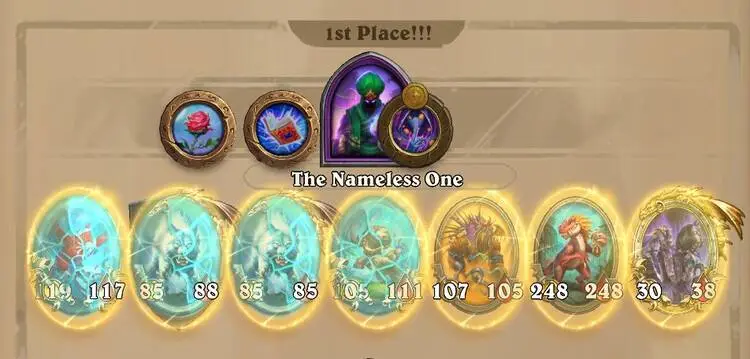
Key minions: Monstrous Macaw, Titus Rivendare, Goldrinn the great Wolf, Lightfeather Screecher
Supporting minions: Rat Pack, Mechanized Gift Horse
Concept: Although the build which you see above requires several very high level minions, it is viable but not in the current meta builds. The other build, focusing on Rally ability of Stomping Stagedon simply is not reliable enough in this patch and doesn’t work well. The key issue here is that pretty much all low and mid-game tier minions are useless near the end (except for Macaw) and will have to be sold. That raises the question of mid-game survivability of this build and that’s why it’s a bit tricky to win with it. Other than that, having a beast comp like you see in the image above, will pretty much handle whatever your opponent has.
Early game: The lowest minion that you need is Monstrous Macaw. This unit is even key in the other build that beasts can make, so called self-inflicting one (scroll to the bottom of the article to find out more about this). In mid-game, focus more on economy and survivability, rather than collecting beasts (especially if you are playing Duos). Try to upgrade to Tavern Tier 5 so that you can start looking for Titus and other triple rewards.
Mid game: This Battlegrounds Beast meta build works as follows: Your Macaw will trigger a Deathrattle, preferably golden one from Goldrinn, the Great Wolf. Titus will repeat that same Deathrattle and hopefully, Macaw will die as it attacks and get reborned (it’s quiet easy to give him Reborn as you will surely get at least few Sprightly Scarabs). Your opponent will hit Goldrinn who will also be reborned and Macaw will attack again, triggering more Deathrattles to occur. The trick is to put Reborn and Macaw and both, Reborn and Taunt on your Goldrinns. You want all of them to die before the enemy starts attacking your “Deathrattle: Summon” minions. If everything goes according to plan, once all Macaw and Goldrinns are gone, it’s time for the party to start. Furthermore, the newest addition in season 11 of Hearthstone Battlegrounds is the Lightfeather Screecher that works perfectly with Macaw and will further activate your Deathrattles.
Late game: In this phase, there is an RNG momment as you can’t put Taunt on your summoning minions as that will nullify the Taunt on Goldrinn, which is far more important. You just have to hope that the opponent doesn’t hit your Titus at this point (odds should be in your favor as you will probably have at least 2 or 3 summoning minions left besides Titus). Anyway, whatever you have there, will summon huge stat monsters as everything is super buffed by those Deathrattles that were activated when Goldrinn died. You can go with Sly Raptor if you don’t have Rat Pack. You can even use Manasaber if you don’t have anything else – the buffs will come from the Deathrattles that were activated so it’s not important how strong the initial summon is, just how many of summons the unit can do. Good luck!
Final Thoughts on the Hearthstone Battlegrounds Strategy for Season 11
Hopefully, this article helped you or at least gave you some new ideas when it comes to Hearthstone Battlegrounds strategy for Season 11. With the introduction of Quests in Season 11, the Hearthstone Battlegrounds meta has shifted significantly. The game feels a bit slower than with trinkets, but overall, it is fun to play. All in all, it is a fresh and very welcome update, so be sure to stay tuned for future updates, because we will for sure update this guide as the meta progresses and new patches come out. Check out our friend’s ElectroHSBG Channel for Duos shenanigans.
